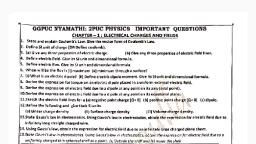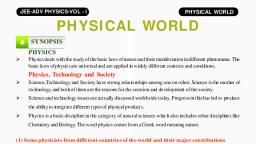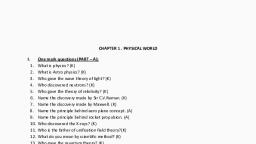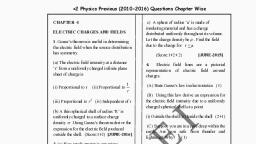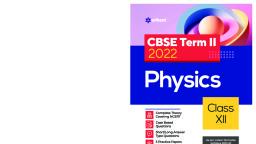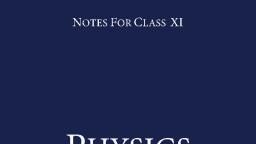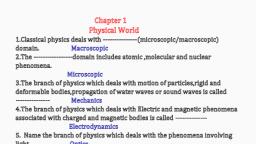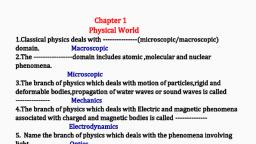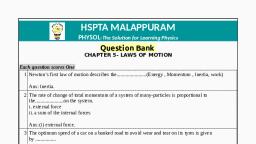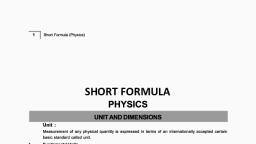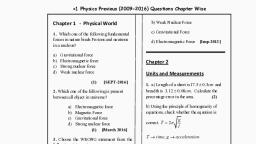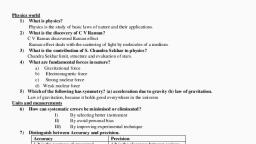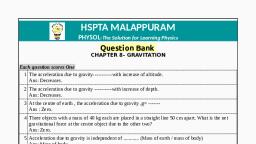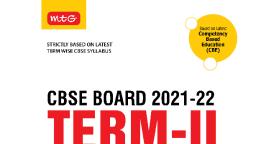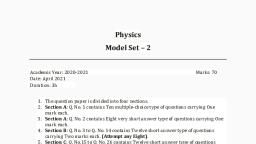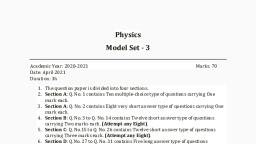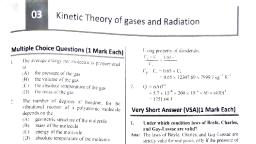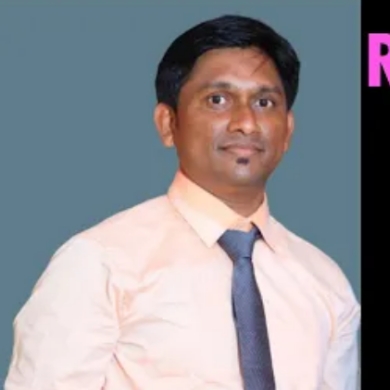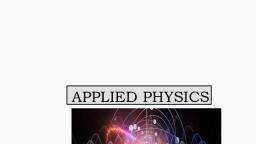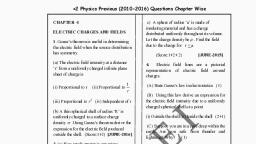Page 1 :
CHAPTER 1 . PHYSICAL WORLD, I., 1., 2., 3., 4., 5., 6., 7., 8., 9., 10., 11., 12., 13., 14., 15., 16., 17., 18., 19., 20., , One mark questions (PART – A):, What is physics? (K), What is Astro physics? (K), Who gave the wave theory of light? (K), Who discovered neutrons? (K), Who gave the theory of relativity? (K), Name the discovery made by Sir C.V.Raman. (K), Name the discovery made by Maxwell. (K), Name the principle behind aero plane concept. (A), Name the principle behind rocket propulsion. (A), Who discovered the X-rays? (K), Who is the father of unification field theory?(K), What do you mean by scientific method? (K), Who gave the quantum theory? (K), Who gave the theory of expansion of universe? (K), What is technology? (K), Which is the strongest force in nature? (K), Which is the weakest force in nature? (K), What is the range of gravitational force? (K), What is the meaning of word ’fusis’? (K), Name the experiment behind nuclear model of the atom? (K), , Two mark questions (PART – B):, 1. Name two fundamental forces in nature. (K)
Page 2 :
Chapter 2, Units and Measurements, I. One mark questions (PART – A):, 1. What is a physical quantity? (k), 2. What is a unit of physical quantity? (K), 3. What are fundamental or basic units? (K), 4. What are derived units? (K), 5. Give the basic units of length in CGS / MKS / FPS / SI system. (K), 6. Given the base units of mass in CGS / MKS / FPS / SI system. (K), 7. How many base units are there in SI system? (K), 8. Name the SI unit of current / temperature / amount of a substance / luminous, intensity. (K), 9. Name the SI unit of angle in a plane. (K), 10. Name the SI unit of solid angle. (K), 11. Mention some direct method of measuring length.(U), 12. Name the method of measuring long distances. (K), 13. What is parallax? (K), 14. What is meant by parallactic angle? (K), 15. Express A0 unit in meters. (U), 16. Name the larger units of length. (K), 17. What is meant by light year? (K), 18. Define unified atomic unit. (K), 19. Which is the instrument used to measure small masses like atom? (K), 20. Mention the types of errors involved in measurements.(K), 21. What is meant by systematic error? (K), 22. What are random errors? (K), 23. What is least count? (K), 24. What is absolute error? (K), 25. How would you determine the true value of a quantity measured several times ? (U), 26. What is relative error? (K), 27. Write the relation for relative error. (K), 28. Write the expression for percentage error. (K), 29. Define astronomical unit (AU) (K), 30. Define parsec. (K), 31. Express parsec in terms of light years. (U), 32. What are significant figures? (K), 33. Does the number of significant figures depend on the choice of unit? (U), 34. State the number of significant figures in the following (U), a)0.006 m2 (b) 2.65 x 103 kg (c) 0.2309 m-3 (d) 6.320 J (e) 0.006032 m2, 35. Round off the following result to three significant figures(U), a) 2.746 (b) 2.744 (3) 2.745 (4) 2.735, 36. Define dimension of a physical quantity. (K), 37. Write the dimensions of work. (K), 38. Define dimensional formula of physical quantity. (K), 39. Write the dimensional formula of volume. (K), 40. Define dimensional equation of a physical quantity. (K), 41. Name a physical quantity which has no units and no dimensions(U)
Page 3 :
42. Name a physical quantity which has units but no dimensions. (U), 43. Name a physical quantity which has neither unit nor dimension. (U), 44. State the principle of homogeneity of dimensions. (K), II. Two mark questions (PART – B):, 1. Mention the fundamental quantities in SI system (K), 2. Name any two derived SI unit with the name of scientist. (K), 3. What are sources of systematic error? (K), 4. Explain the method of reducing systematic error. (K), 5. Give any two methods of reducing least count error. (K), 6. The distance ‘D’ of the sun from the earth is 1.496 x 1011 m. if sun’s angular diameter, is 9.31 x 10-3 rad as measured from earth, find the diameter of the sun. (S), 7. State the rule to find the absolute error when two quantities are added or, subtracted., Write the expression. (K), 8. State the rule to find the relative error when two quantities are multiplied or, divided., Write an expression. (K), 9. Find the relative error in Z ,if Z = A3 B1/2 / C D3/2 (U), 10. Explain scientific notation method of finding the number of significant figures. (K), 11. Write the dimension of universal gravitational constant. (u), 12. Mention two pairs of physical quantities which have the same dimensions. (U), 13. Mention the physical quantities whose dimensions are (i) [M1 L-1 T-2] (ii) [M1 L2 T-3] (K), 14. What are the dimensions of a and b in the relation F = a1/2+ bt2 where F is force , x is, distance and t is time. (U), 15. Mention any two constants which have dimensions. (U), 16. Mention any two applications of dimensional analysis. (U), Three mark questions (PART – C), 1. Check the correctness of following equation by dimensional analysis., x = x0 + v0t + 1/2at2, 2. Check the correctness of following equation by dimensional analysis., F x = ½ mvo2 – ½ mv2 (S), Five mark questions (PART – D):, 1. The period of oscillation of a simple pendulum is T = 2, , . the measured value of, , L is 20.0 cm known to 1 mm accuracy and time for 100 oscillations of the pendulum, is found to be 90 s using a watch of 1s resolution. Find accuracy in % error. (S), 2. The period of oscillation of a simple pendulum depends on its length (l) , mass of the, bob (m) and acceleration due to gravity (g) . derive the expression for its time period, using method of dimensions. (K), 3. The centripetal force (F) acting on a particle moving uniformly in a circle depends, upon its mass (m), velocity (v) and radius of circle (r). derive the expression for, centripetal force using method of dimensions._ (S)
Page 4 :
I., 1., 2., 3., 4., 5., 6., 7., 8., 9., 10., 11., 12., 13., 14., 15., 16., 17., 18., 19., 20., 21., 22., 23., 24., 25., 26., 27., 28., 29., 30., 31., 32., 33., , CHAPTER 3, Motion in a Straight line, One mark questions (PART – A):, When does an object said to be in motion? (K), What is rectilinear motion? (K), What is meant by path length? (K), Define displacement? (K), What is the position - time graph? (K), Define uniform velocity. (K), Define speed of a body. (K), Define Velocity of a body. (K), Define instantaneous velocity of a body in terms of its average velocity., The average velocity of a body is equal to its instantaneous velocity. What do you, conclude by this? (U), What does the slope of position - time graph represent? (K), What is meant by uniform motion? (K), Define average acceleration. (K), Define instantaneous acceleration of a body in terms of its average acceleration. (U), What does the slope of velocity - time graph represent? (K), What does area under velocity - time graph represent? (K), When does relative velocity of two moving objects zero? (U), What is the acceleration of a body moving with constant velocity? (U), If a car is traveling towards east can its acceleration be west ward? (U), When does an object said to be at rest? (K), A body moving along a circular path with uniform speed. Does it has acceleration., (K), What is position - time graph? (K), What is velocity - time graph? (K), What is acceleration - time graph? (K), Draw the v-t graph of a body thrown vertically upwards. (U), Draw the x-t graph of a body thrown vertically upwards. (U), Draw the v-t graph of a body starting from rest & moving with uniform velocity. (K), What does speedometer of a car measures? (A), Two trains are moving in opposite directions with speeds 20 ms-1& 10 ms-1 . The, relative velocity of the trains is ans (30 ms-1) SWhat is stopping distance? (A), What is reaction time in motion? (K), When will the relative velocity of two moving bodies zero? (U), A car starting from rest has an acceleration of 5 ms-2. How fast will it be after 10s., ( 50 ms-1)S, A body is thrown vertically upward from the surface of the earth . What is the, direction of acceleration of the body? (U
Page 5 :
34. What is free fall? (K), Two mark questions (PART – B):, 1. Distinguish between distance and displacement. (K), 2. Distinguish between speed and velocity. (K), 3. Draw the position - time graph for an object (i) at rest (ii) with uniform motion. (U), 4. Draw the position - time graph for an object (a) moving with positive velocity and, (b) Negative velocity(U), 5. Draw position - time graph for motion with (a) positive acceleration (b), negativeacceleration (c) zero acceleration. (U), 6. Draw velocity - time graphs for motion in (a) positive direction with positive, acceleration (b) negative direction with negative acceleration. (U), 7. Find The displacement (in m) of a particle moving along x - axis given by, x = 20t - 10t2 . Calculate the instantaneous velocity at t = 2s. (S) ( 60 ms-1, 8. A ball is thrown vertically upward and it reaches a height of 90 m. Find the, velocity with which it was thrown. Ans 42 m/s (S), 9. Define relative velocity with an example. (K), 10. A car travels with a uniform velocity of 20 m-1.The driver applies the brakes and the, car comes to rest in 10 second. Calculate the retardation. (S) (a = - 2 ms-2), 11. A ball is thrown vertically upwards, At highest point of its path what will be its, instantaneous velocity & acceleration. (U), 12. Two ball different masses (one lighter & other heavier) are thrown vertically with the, same speed u from the top a of a tower. Which one will pass through the point of, projection in the downward direction with the greater speed? (U), 13. Can the displacement may be positive negative or zero? Explain. (U), 14. Distinguish between speed and velocity. (K), 15. A body moves along a circular path of radius 2m.What are displacement & distance, traveled by the body for one complete revolution? (S), Three mark questions (PART – C):, 1. a) What is the velocity - time graph? (K), b) Show that area under velocity - time graph is equal to displacement. (K), 2. a) Define relative velocity of an object w.r.t another. (K), b) Draw position - time graphs of two objects moving along a straight line when their, relative velocity is (i) zero and (ii) non – zero (K), 3. What is the significance of velocity - time graph? (K), 4. What is the significance of displacement - time graph? (K), 5. Derive the equation of motion v = v0 +at(K), 6. A car is moving along a straight line AB= 360m. It move s from A to B in 18 S &, returns from B to A in 6 s. Find the average velocity & average speed. (S), Five mark questions (PART – D):, 1. Derive the equation of motion v2 = v02 +2ax using v-t graph. (K), 2. Derive the equation of motion x = v0 t + ½ a t2 using v-t graph. (K)
Page 6 :
1. A car moving along a straight highway with speed of 126 km / hr brought to stop, within a distance of 200 m. What is the retardation of the car and how long does it, take for the car to stop? (S), ( t = 11.66s), 2. A balloon is ascending with a velocity of 9.8 ms-1, a sand bag is dropped from the, balloon when it is at a height of 39.2m from the ground. Calculate the time taken by, bag to reach the ground. (S), ( t = 4 s.), 3. A car starts from rest and accelerates uniformly at a rate of 2 ms-1 for 20 second.It, then maintains a constant velocity for 10 second. The brakes are then appliedand, the car is uniformly retarded and comes to rest in 5 second. Find the distance, travelled. (S), Ans 900m, 4. A stone is dropped from the top of a tower 400 m high and at the same time another, stone is projected upward vertically from the ground with a velocity of 100 ms-1., Find where and when the two stones will meet. (a = 10 ms-2). (S), Ans:x = 320m, 5. Two trains are moving in opposite directions. Train A moves east with a speed of 20, ms-1 and train B moves west with a speed of 30 ms-1 . What is the (i) relative velocity, of B w.r.t A and (ii) the relative velocity of ground w.r.t B. (iii) A monkey is running, on the roof of train A against its motion with a velocity of 10 ms-1 w.r.t train A. What, is the velocity of the monkey as observed by a man standing on the ground? (S), 6. Two trains A and B of length 300 m each are moving on two parallel tracks with a, uniform speed of 15 ms-1 in the same direction, with the train A ahead of B. The, driver of train B decides to overtake train A and accelerates by 2 ms-2. If after 25s,, the guard of train B brushes past the driver of train A, what was the original distance, between the two trains? (S), (x = 25m), 7. A body is thrown vertically up from the top of a building with a velocity of 10 ms-1 It, reaches the ground in 5 s. Find the height of the building and the velocity with which, the body reaches the ground. (g = 10 ms-2).(S), (h = 75 m)., 8. A ball is thrown with a velocity 30 ms-1 from the ground . How high it will rise., Calculate the time taken to reach the ground. (g = 10 ms-2). (S), (Total time = 6 s)
Page 7 :
CHAPTER 4, , Motion in a plane, I., , One mark questions (PART – A):, , 1., 2., 3., 4., 5., 6., 7., 8., 9., 10., , What is a scalar quantity? (K), Give an example for scalar quantity. (U), Give an example to show that scalar addition obey ordinary addition rules (U)., What is a vector quantity? (K), Give an example for vector quantity. (U), How does vector quantity is different from scalar quantity. (U), Graphically represent a vector. (S), What is a position vector? (K), What is a displacement vector? (K), What are equal vectors? (K), , 11., 12., 13., 14., 15., 16., 17., 18., 19., 20., 21., 22., 23., 24., 25., 26., 27., 28., 29., 30., 31., 32., 33., 34., 35., 36., 37., , is multiplied by-1.5, graphically represent the resultant vector. (S), Give an example for vector multiplied by a scalar. (U), What is a negative vector? (K), State triangle law of vector addition. (K), Does the vector addition obey the commutative law? (K), Does the vector addition obey the associative law? (K), Define a null vector. (K), What do you mean by resolution of a vector? (K), Define a unit vector. (K), Graphically represent the unit vectors along X, Y, Z axes of a rectangular co-ordinate system. (S), What are components of a vector? (K), What should be the angle between two vectors for their resultant to be maxi mum? (A), What should be the angle between two vectors for their resultant to be minimum? (A), What is the magnitude of resultant of two equal vectors acting right angles to each other? (A), Mention the expression for position vector in X-Y plane. (K), What is a projectile? (K), Give an example for projectile. (U), What is the trajectory of a projectile motion? (K), Define time of flight of a projectile motion. (K), Define maximum height of a projectile motion. (K), Define horizontal range of a projectile motion. (K), If velocity of projection is doubled what happens to the maximum height of projectile? (U), Which component of velocity of a projectile is constant? (U), Which component of velocity of a projectile is zero at the maximum height? (U), Which component of acceleration of a projectile is zero? (U), Mention the expression for time of flight of a projectile =90°. (U), What is the horizontal range of a projectile if =90°. (U)
Page 8 :
38. What is the angle between direction of velocity and acceleration at the maximum height of a, projectile? (U), 39. For what angle of projection, horizontal range is maxi mum? (A), 40. For what angle of projection, height is maxi mum? (A), 41. Mention the expression for maximum horizontal range of a projectile. (U), 42. For a given velocity of projection, height and horizontal range are maxi mum. Mention the, relation between range and height of projectile. (A), 43. If Velocity of projection is same, then for which two angles of projection horizontal range is, same? (A), 44. How does air resistance affects the maximum height of a projectile? (A), 45. What happens to range, if velocity of projection is doubled keeping the same angle of, projection? (A), 46. Which physical quantity remains the constant for a particle in uniform circular motion? (K), 47. At what point of trajectory of projectile, speed is minimum. (U), 48. What is the angle between direction of velocity and acceleration of a particle in uniform circular, motion? (A), 49. Define centripetal acceleration (K)., 50. Mention the expression for centripetal acceleration. (U), , Two mark questions (PART – B):, 1., 2., 3., 4., , Give two differences between scalar and vector quantity. (U), Classify the following into scalar and vector quantity., Mass, speed, velocity, displacement, weight, acceleration, time. (U), Write two properties of vector addition. (K), What is two dimensional motion? Give one example. (K), , 51. Write the expression for X and Y component of, 52. Given, , = 2 ̂ +4 ̂ and, , = 3 ̂ - ̂ determine (a), , when, +, , makes an angle, (b), , with the X axis. (U), , − 2 . (S), , 53. Graphically show the subtraction of from . (S), 54. Explain triangular law of vector addition. (U), 55. Explain parallelogram law of vector addition. (U), 56. What is the unit vector of = 2 +̂ 3 ̂ . (S), 57. Graphically represent the displacement vector in X-Y plane. (S), 58. A boy moves from point P (1, 2) to point P 1(3, 4) in X-Y plane in t seconds. Find the magnitude, of the displacement vector of the boy in t seconds. (S), 59. Write the expression for magnitude of the resultant of two vectors making an angle between, them. Explain the terms. (U), 60. Write the expression for direction of the resultant of two vectors making an angle between, them. . Explain the terms. (U), 61. Draw the graph showing the variation of component of velocity with time during the motion of a, projectile. (S), 62. Write the expression for trajectory of projectile. Explain the symbols used. (U)
Page 9 :
63., 64., 65., 66., 67., (U), 68., , Define time of flight of a projectile motion .Write the expression for it. (U), Define horizontal range of a projectile motion. Write the expression for it. (U), Define maximum height of a projectile motion. Write the expression for it. (U), What is the direction of velocity and acceleration of a particle in uniform circular motion? (U), For a particle in uniform circular motion speed is uniform, but its velocity is non uniform, explain., Define centripetal acceleration. Write the expression for it. (U), , Three mark questions (PART – C):, 1. Given = 4 +̂ 4 . Find the magnitude and direction of velocity vector. (S), 2. Explain resolution of a vector in a plane. (U), 3. A vector having a magnitude of 15unit makes an angle 60°with the X axis. Find the horizontal and, vertical, component? (S), 4. Derive the expression for time of flight of a projectile. (U), 5. Derive the expression for horizontal range of a projectile. (U), 6. Derive the expression for maximum height of a projectile. (U), 7. Find the angle of projection at which maximum height and range are equal? (A) (1200), 8. Two vectors both equal in magnitude have their resultant equal to magnitude of either vector. Find, the angle between the two vectors. (S), 9. Find the angle between two vectors of magnitude 4 unit and 6unit, so that their resultant is 8unit., (S) (14°021), 10. Stone of mass 0.5 kg tied to a string of length 2m is rotated in horizontal plane with a speed of, 5ms-1.Calculate centripetal acceleration and centripetal force. (S), (12.5 ms-1, 6.25N), 11. A ball is projected with a velocity of 20ms-1.After two seconds its vertical displacement is, 10m.Calculate the angle of projection. g=10ms-2(S) (480351), 12. From the top a building of height 200m, a projectile is fired horizontally with a velocity of 6ms-1., Find the time taken to reach the ground. g=10ms-2 (S) (6.32S), , Five mark questions (PART – D):, 1. Obtain the expression for magnitude and direction for the resultant of two vectors making an angle, between them. (U), 2. What is a projectile? Derive the equation for path of a projectile. (U)., 3. Show that the trajectory of projectile is parabola. (U), 4. Define centripetal acceleration .Derive the expression for it. (U), Problems, 1. The position of a particle is given by = (4t ̂ +2t2 ̂ +2 ) m. Where ’t’ is in second., (a) What is the velocity and acceleration of the particle?, (b)Calculate the magnitude and direction of velocity at t=2s. (S), (8.94ms-1, 630261 with the X axis)
Page 10 :
2. The position vector of the particle is (2 ̂ +3 ̂) m at t=0. Velocity of the particle becomes (3 ̂ +6 ̂) ms-1, at t=2s. Then find the position vector of the particle at t=2s.What is the X and Y co ordinate? (S) (, = 8 ̂ + 15 )̂ , (8, 15), 3. The greatest and least resultant of two forces acting at a point are20N and 4N respectively. If each, force is increased by 4N, the new forces are perpendicular to each other. Find the resultant of new, forces. (S) (20N), 4. On a rainy day rain is falling vertically with a speed of 10ms-1.Wind starts blowing with a speed of, 5ms-1 in east to west. What is the magnitude of the resultant velocity? At what angle should a girl, waiting at a bus stop hold her umbrella? (S) (5√5 , 260331), 5. A bullet is fired with a speed of 40ms-1at an angle 30° with horizontal .Calculate the maximum, height, time of flight, horizontal range of the bullet. g=10ms-2(S) (20m, 4s, 138.5m), 6. A body is projected with a velocity of 40ms-1 at an angle 30° with the vertical. Calculate the, maximum height, time of flight, horizontal range of the bullet. g=10ms-2(S), (60m, 6.9s, 138.5m), 7. A ball is thrown with velocity 45ms-1.The horizontal distance reached by the ball is 30m.Calculate, (1) Angle of projection (2) Maximum height reached by the ball. g=10ms-2(S) (320581), 8. A projectile has a horizontal range of 52m and maximum height of 12m. Calculate the angle at, which the projectile is fired? g=10ms-2(S) (120591), 9. From the top a building of height 450m, a projectile is fired horizontally with a velocity of 25ms-1., g=10ms-2, (a) Find the velocity with which projectile hits the ground., (b)Find the time taken to reach the ground., (c) Find the horizontal distance between base of the building and point where it hits the ground. (S), (98.10ms-1, 9.48s, 237N), 10. A cricketer can throw a ball to maximum horizontal distance of 125m, calculate maximum height, moved by ball. g=10ms-2 (S) (31.25m)
Page 11 :
CHAPTER, Laws of motion, One mark questions (PART – A):, 1., 2., 3., 4., 5., 6., 7., 8., 9., 10., 11., 12., 13., 14., 15., 16., 17., 18., 19., 20., 21., 22., 23., 24., 25., 26., 27., 28., 29., 30., 31., 32., 33., 34., 35., 36., 37., , What is inertia? (K), What is the measure of inertia? (K), Give an example for inertia of rest. (U), State Newton’s first law of motion. (K), Passengers standing in a stationary bus fall backward, when the bus suddenly starts moving, forward. Give reason. (A), Give an example for inertia of motion. (U), Define linear momentum of a body. (K), Write the S.I. unit of linear momentum. (K), State Newton’s second law of motion. (K), Why athletes run a few steps before taking a jump? (A), Bullet fired from a gun makes more damages than the bullet of same mass if thrown .Why? (A), Why a cricketer draws his hands while catching a ball? (A), Write the S.I. unit of force. (K), Define S.I .unit of force. (U), What is the force acting on a body of mass 1 g producing an acceleration of 1 cms-2? (U), What is the force acting on a body, where rate of change of momentum is 3kgms-1? (A), Write the dimensional formula of force. (U), Define impulse of a force. (K), What is the net force acting on a body moving with uniform velocity? (U), What happens to the acceleration of the body if net force acting on the body is doubled? (U), Give one example for impulsive force. (U), Mention the expression for impulse. (U), Write the S.I. unit of impulse. (U), Write the dimensional formula of impulse. (U), State Newton’s third law of motion. (K), Give one example for Newton’s third law of motion. (U), State the law of conservation of linear momentum. (K), Give one example that illustrates the law of conservation of linear momentum. (U), What are concurrent forces? (K), What is the condition for equilibrium of two forces acting on a body? (U), Name one contact force in mechanics. (K), Name one non contact force in mechanics. (K), What is frictional force? (K), What is meant by normal reaction force? (K), Define static friction. (K), What is meant by the limiting friction? (U), Define kinetic friction. (K)
Page 12 :
38., 39., 40., 41., , Define rolling friction. (K), Why ball bearings are placed between moving parts of a machine? (A), Which is greater, µk or µs? (U), What is the angle between frictional force and instantaneous velocity of motion over a rough, surface? (A), 42. Give one example to show that friction is critically needed. (U), , Two mark questions (PART – B):, 1. Write the mathematical form of Newton’s second law of motion. Explain the terms. (U), 2., Why a force is necessary to whirl the stone tied to a string with uniform speed in a horizontal, plane? Explain. (A), 3., No force is needed to move a body with constant velocity. Explain. (U), 4., Explain any one illustration that uses Newton’s third law of motion in our daily life. (A), 5. Explain why forces of action and reaction cannot cancel even though they are equal and opposite?, (A), 6. Force of 9N acting on a body for 0.03s. Calculate the impulse. (A), 7. Explain any one example that uses law of conservation of linear momentum (U), 8. Write the expression for coefficient of static friction. Explain the terms used. (U), 9. Write the expression for coefficient of kinetic friction. Explain the terms used. (U), 10. Mention two methods of reducing the friction. (U), 11. Mention two disadvantages of friction. (U), 12. Mention two advantages of friction. (U), 13. An object of mass 15 kg is moved on a horizontal surface by a force of 75N .Calculate the, coefficient of friction. g=10ms-2. (S), 14. Write the expression for maximum speed of circular motion of the car on a rough level road., Explain the terms used. (U), 15. Write the expression for maximum speed of circular motion of the car on a rough banked road, .Explain the terms used. (U), 16. What is the need for banking the circular road? Explain. (U), 17. On the banked circular road, name the forces which provide the necessary centripetal force? (U), , Three mark questions (PART – C):, 1., 2., 3., 4., 5., 6., 7., , State Newton’s laws of motion. (K), State Newton’s first law of motion and hence define force and inertia of a body. (U), Mention the three types of friction. (K), State the laws of friction (U)., What is the condition for equilibrium of three concurrent forces acting on a body. Explain with, vector diagram. (S), A force of 2N is acting on a body of mass 1kg.Starting from rest how much distance the body moves, in 5s? (S) (12.5N), A body of mass 5kg is moving with a velocity of 10ms-1.How long does the body take to come to, rest when a force of 8N acts on body? (S)(6.25s)
Page 13 :
8., , A block of 30N weight rests on a rough surface. A horizontal force of 10N required to start the, motion of the block on the surface and a force of 7N will keep the block in uniform motion on the, surface. Find µk and µs. (S) (0.233, 0.333), , Five mark questions (PART – D):, 1., 2., 3., , State Newton’s second law of motion and hence derive F=ma. (U), State and prove the law of conservation of linear momentum from Newton’s third law of motion., (U), Derive an expression for maximum speed of circular motion of the car on a rough banked road. (U), , Problems, 1. Two perpendicular forces of 3N and 4N are acting on a body of mass 2kg. Calculate the magnitude, and direction of acceleration of the body. (S)(2.5ms-2, 530071 with3N ), 2. Stone of mass 3kg is dropped from the top of a building 25m high on a heap of sand. Stone, penetrates 0.5m deep in sand. Calculate the retarding force exerted by the sand on stone., (-1500N), g=10ms-2(S), 3. Bus of mass 4000kg is moving with a speed of 54km/h on a level road. Calculate the force required, to stop the bus in a distance of 40m. (S)(-11,250N), 4. A body of mass 0.5kg moving with a velocity 10ms-1 is stopped by a force of 2N. Calculate the, impulse of the force. (S)(5Ns), 5. A body of mass 1kg moving with a velocity 15ms-1 is stopped in 2s.Calculate the impulse and, opposing force. (S)(15Ns,-7.5N), 6. A bullet of mass 100g is moving with a speed of 50ms-1 enters a heavy wooden block and is stopped, after a distance of 50m.What is the resistive force exerted by the block on the bullet? (S)(-0.225N), 7., Two balls each of mass 45g moving in opposite direction with a speed of 15ms-1 are collide and, rebounds with same velocity. Calculate the impulse imparted to each other. (S), (1.35kgms-1,-1.35kgms-1), 8. Bullet of mass 30g is fired from a gun of mass 10kg with a velocity 300ms-1.What is the recoil, velocity of the gun?(S) (-0.9ms-1), 9. A body of mass 14kg moving with a velocity 4ms-1 along the X axis explodes into two parts of, masses 8kg and 6kg. The heavier mass part moves along X axis with 10ms-1.Find the velocity of the, smaller part. What is the direction of velocity of smaller part? (S) (-4ms-1,-Xaxis), 10. A man of mass70kg stands on a weighing machine lift which is moving,, What should be the reading on the scale if (a) Lift moves upwards with a uniform speed 10ms-1., (b) Downwards with a uniform acceleration of 5ms-2. (c) Upward s with a uniform acceleration of, 5ms-2., Given g=10ms-2. (S), (0,350N, 1050N), 11. Two bodies of masses 10kg and 20kg respectively kept on a smooth horizontal surface are tied to, the ends of a light string. A horizontal force600N is applied to (1) 10kg mass (2) 20kg mass along, direction of the string. What is the tension in the string in each case? (S) (400N, 200N)
Page 14 :
I., , One mark questions (PART – A):, , 1. Define Scalar or dot product of two vectors. (K), 2., , If A.B = 0 , then what is the angle between A and B ? (S), , 3., 4., 5., 6., 7., 8., 9., 10., 11., 12., 13., 14., 15., 16., 17., 18., 19., 20., 21., 22., 23., 24., 25., 26., 27., 28., , If A.B = AB , then what is the angle between A and B ? (S), Mention expression for work done by a force in vector form (U), Define work done by the force (K), When does the work done by a force is zero ? (S), Define work-energy theorem (K), Mention the dimensions of the work done (S), Is work a scalar or vector? (S), Express joule in calorie. (K), What is the nature of the work done by frictional force? (A), What does the area under ‘force – displacement’ curve represent? (S), Define potential energy ? (K), Can potential energy of on object be negative? (S), Write expression for the potential energy stored in a spring (K), What is elastic collision? (K), What is the value of one-horse-power in watt? (S), What is kinetic energy? (U), What is spring force? (K), Write the S.I unit of spring constant. (U), Whether the spring force is conservative or non-conservative ? (U), What is the energy associated with 1 kg of mass. (S), Define power (K), What does area under the graph of force against displacement graph represent (K), State principle of Conservation of energy. (K), Define Power.(K), Write the SI unit of power. (U), Write the dimension of power.(U), , 29. Express joule in kilowatt hour (S), 30. Give an example for zero work (U), Two mark questions (PART – B):, 1. Find the cosine of the angle between the vectors A = 2iˆ − 4 ˆj − 5kˆ and B = 2iˆ + 2 ˆj − 4kˆ .(S), 2. Define work done by the force. What is value of work done by the centripetal force? Explain. (K), 3., 4., 5., 6., 7., 8., 9., 10., 11., 12., 13., 1, , State any two conditions under which a force does no work.(U), How do you represent graphically work done by a variable force and by a constant force? (S), What is non conservative force ? Give an example. (U), What is conservative force? Give an example. (U), Mention the expression for the work done by a spring force. (K), Mention the two types of Mechanical energies. (U), What is power? Show that power is equal to the product of force and velocity. (K), Distinguish between elastic and inelastic collision (U), What is elastic collision? Give an example. (U), What is inelastic collision? Give an example (K&U), What is perfectly inelastic collision? Give an example.
Page 15 :
14. Find the magnitude of a vector A = 0iˆ + 3 ˆj + 4 kˆ (S), Three mark questions (PART – C):, Prove work –energy theorem for a constant force. (K), What is meant by collision? Distinguish between elastic and inelastic collision.(U), Derive expression for kinetic energy (K), Calculate the work done by a man in carrying a load of 100 kg over his head through a distance, of 10m in a vertically upward direction. (S), 5. When does work done is i) + ve, ii) –ve, iii) zero, (A), 6. Distinguish between conservative force and non-conservative force., (U), 7. Convert one kilowatt hour into joules (S), 8. Explain graphically the work done by a variable force.(K&S), 9. Draw a graph showing the variation of kinetic energy and potential energy with displacement of, a loaded spring.(S), 1., 2., 3., 4., , Five mark questions (PART – D):, 1. State law of conservation of mechanical energy and illustrate the same in case of a freely falling, body.(U), 2. Derive an expression for potential energy of stretched spring.(K), 3. State Work- energy theorem .Prove it in case of a variable force.(S), 4. Obtain the expression for loss in K.E. during an inelastic collision.(K), 5. Obtain the expression for final velocities of two bodies in one dimensional elastic collision.(K), Five mark questions-numericals. (PART – D):, 1. A pump on the ground floor of a building can pump up water to fill a tank of volume 30m3 in 15, min. If the tank is 40m above the ground, and the efficiency of the pump is 30%, how much, electric power is (Ans: 43.557kW), 2. A bullet of mass 50gm moving with a velocity of 400m/s strickes a wall and goes out from the, other side with a velocity of 100m/s. Calculate the work done in passing through the wall., (Ans3750 J), 3. A pump on the ground floor of a building can pump up water to fill a tank of volume 40m3 in 20, minutes. If the tank 30m above the ground and the efficiency of the pump is 60%, How much, electric power is consumed by the pump? Given density of water =1000 kg/m3 and acceleration, due to gravity =9.8m/s2.( Ans 16.33kwatt), 4. A pilot of an aero plane fires a shot weighing 0.1kg with a vertical of 300ms-1. Calculate the total, energy of the shot when it is at a height of 500m above the ground.(Ans 4990 J), 5. A pump is required to lift 600kg of water per minute from 920m deep well and ejects it with a, speed of 10ms-1. What will be the power of pump required ? (Ans 92.5 kJ.), 6. A constant force of 3.5 N accelerates a stationary body of mass 20 kg through a displacement of, 3.5 m. Find the work done. (Ans :12.25 J), 7. A bob of a simple pendulum is released from a horizontal position. What is the speed with when, the bob crosses the mean position if 20% of its initial energy lost in air resistance (g=9.8m/s2), (Ans :4.85 m/s), 8. A person pushes a trunk on railway platform. He applies a force of 150N over a distance of 10m., Thereafter he gets progressively tired and his applied Force reduces linearly with distance to, 2
Page 16 :
100N. The total distance through which truck has moved is 20m. Plot F-S graph and also, calculate work done by that person., (Ans : 4000J ), 9. A man weighing 48kg carries a bag of 2kg. He climbs to the top of building 100m all in 5 minute., Calculate the work done by the man and his power in watts and in horse power., ( Ans : 163.3 W& 0.218 H P ), 10. A variable force given by F=x +8 acts on a particle. Calculate the work done by the force during, the displacement of the particle from x=1m to x=3m.(Ans : 20 J), 11. From what height should a body of mass 40kg fall in order to have same kinetic energy as a, body of mass 1.96kg travelling at 12ms-1. (Ans: h= 0.36m), 12. A rain drop of mass 1kg falling from a height 1km hits the ground at a speed 50ms-1.Calculate the, work done by the gravitational force and (ii) work done by the unknown resistive force., (Ans : 9.8 J & 8.55 J ), 13. A railway engine of mass 60.3 tones is running at a speed of 12ms-1 . What is the additional, power must is develop in order to increase its speed to 18ms-1 in 5 secs? (Ans= 434.13 103 W), , **********************************************************************************, , 3
Page 17 :
Chapter 7. System of particles & rotational motion, I., , One mark questions (PART – A):, 1. What is translational motion? (K), 2. What is rotational motion? (K), , 3., 4., 5., 6., 7., 8., 9., 10., 11., 12., 13., 14., 15., 16., , Give an example for particle having both translational and rotational motion. (U), What is precession motion? (U), What is the center of mass of a system of particles? (K), Give the location of centre of mass of a sphere of uniform mass density? (S), Give the location of centre of mass of cylinder of uniform mass density. (S), Give the location of centre of mass of ring of uniform mass density? (S), Give the location of centre mass of a cube of uniform mass density? (S), Does the centre of mass of a body necessarily lie inside the body? (A), Define average angular velocity. (K), Define angular acceleration (U), Is moment of force a vector or a scalar? (K), What is the mechanical advantage of a lever. (K), What is meant by a mechanical advantage of a lever? (K), Write the expression for the torque in terms of position vector and force. (U), , 17. Write the expression for the torque in terms of moment of inertia and angular acceleration. (U), 18. What is the S.I. unit of Torque? (S), 19. Write the dimensions of torque, 20. Write the expression for the angular momentum in terms of linear momentum and position, vector. (U), 21. Write the expression for angular momentum in terms of moment of inertia and angular velocity, (U), 22. Define angular momentum (K), 23. Define a couple. (K), 24. Define moment of a couple. (U), 25. The mechanical advantage of a lever is greater than one what does it mean? (K), 26. Is moment inertia a vector or a scalar? (K), 27. Write the SI unit of moment of inertia.(U), 28. Define the term Radius of gyration (K), 29. How is Torque related to the angular momentum.( A), 30. What is the direction of angular velocity? (S), 31. Define moment of a couple.(K), 32. Name the physical quantity which is equal to the time rate of change of angular momentum.(U), 33. Give the expression for moment of Inertia of a thin rod about an axis perpendicular to the rod, and passing through its mid point.(U), 34. Write the expression for the moment of inertia of a circular disc of radius R about an axis, perpendicular to it and passing through its centre. (U), 35. Write the expression for the moment of inertia of a circular disc of radius R about its, diameter.(U), 36. Give the expression for moment inertia of a hollow cylinder of radius R about its axis. (K)
Page 18 :
37. Give the expression for moment of inertia of a solid cylinder of radius R about its axis. (K), 38. Give and expression for the moment of inertia of a solid sphere of radius R about its diameter.(K), , Two mark questions (PART – B):, 1. Write the expression for the position vector of the centre of mass of a system consisting of two, objects in terms of their masses and position vectors. (K), 2. Write an expression for position vector of centre of mass of a rigid body. (K), Write expression for Linear momentum of system of particles (k), , 3., , 4. Write a formula for instantaneous angular velocity. (K), 5., 6., 7., 8., 9., 10., , What is the relation between angular velocity and linear velocity? (U), Define angular momentum. Write the expression for it., Define angular acceleration. Write an expression for it., Define torque. Write an expression for it. (S), What is couple? Give an example for couple. (U), Give the general conditions of equilibrium of a rigid body. (A), 11. Write an expression for rotational kinetic energy.. (K), 12. Write the expression for the total kinetic energy of a rolling body. (K), 13. Write one practical use of moment of inertia OR Why a fly wheel is used in an engine of a, vehicle? OR What is a flywheel? (A), , Three mark questions (PART – C):, 1. Find moment of inertia of rigid massless rod of length with a pair of small masses rotating about, an axis through the centre of mass perpendicular to the rod.(S), 2. Explain the principle of moments for a lever. (U, 3. Obtain an expression for the kinetic energy of a rotating body.(U), 4. Compare the linear motion and rotational motion(A), 5. Write the kinematic equations of a body rotating with uniform angular acceleration.(K), 6. Write the expression for the total kinetic energy of a rolling body.(K), 7. Find the torque of a force F = 7iˆ + 3 ˆj − 5kˆ about the origin. The force acts on a particle whose, position vector is r = iˆ − ˆj + kˆ, , Ans : τ = 2iˆ + 12 ˆj + 10 kˆ, , (S), , Five mark questions (PART – D):, 1. State and explain theorem of perpendicular axis and of parallel axis (U), 2. Using perpendicular axis theorem obtain the expression for the moment of inertia of a disc, about its diameter. (K), 3. Show that τ =Iα. Symbols have usual meaning.(k), 4. Derive an expression for the kinetic energy of a rolling body.(k), , Five mark questions( numericals) (PART – D):, 1. A flywheel of mass 12.5 kg and diameter 0.36m rotating at 90rpm has its speed increased to, 720 rpm in 8s. Find the torque applied ( Ans 1.669Nm)(S), 2. A meter stick is balanced on a knife edge at its centre. When two coins, each of mass 5g are put, on the top of the other at 12.0cm mark, the stick is found to be balanced at 45cm. What is the, mass of the meter stick ? ( Ans 66 x 10-3Kg)(S), 3. A disc of mass 200kg and radius 50cm is rotating at the rate of 480rpm. Find the work done to
Page 19 :
bring the disc to rest. If the disc is stopped in 11 rotations, calculate retarding torque acting on, the disc. (Ans : 457 Nm), 4. The angular speed of a motar wheel is increased from 1200rpm to 3120 rpm in 16 seconds., What is its angular acceleration, assuming the acceleration to be uniform ? (Ans : 4π rad/s2), 5. The speed of a heat engine increases from 420rpm to 6360 rpm in 18 s. Calculate a) angular, acceleration b) angular displacement and c) number of revolutions does it make in this period, of time. (Ans : α = 34.54 rad/s2, θ= 2034 πrad and n= 1017), 6. Find the centre of mass of three particles at the vertices of an equilateral triangle. The masses, of the particles are 100g, 150g, and 200g respectively. Each side of the equilateral triangle is, 0.5m long., 7. A uniform rod of length 1m and mass 20kg is supported horizontally on 2 knife edges at the, ends. Two masses of 6kg and 10kg are suspended at 0.3m and 0.7m from one end of the rod., Find the reactions on the knife edges., 8. Five bodies 1kg wt., 2kg wt., 3kg wt., 4kg wt. and 5kg wt. are suspended at a distance of 1m,, 2m, 3m, 4m, and 5m from one end of a uniform rod of mass 4kg and 6 metres length. Find the, point about which the rod will balance about the knife edge placed at a distance of ‘x’ from the, end A., 9. A ladder of mass 10kg and length of 4 metres rests with one end against a smooth vertical wall, and the other end against a smooth floor. The ladder is inclined at 600 to the horizontal., Calculate the horizontal force to be applied to the lower end to prevent from sliding down. 10, seconds, calculate the angular and linear acceleration., 10. A uniform rod of mass 8kg and length 4m rotates at the rate of 60 rotations per minute about, an axis passing through the centre and perpendicular to its plane. If the speed of rotation, changes to 80 rpm in 10 seconds. Calculate the torque applied., 11. A cord of negligible mass is wound round the rim of a fly wheel of mass, 20 kg and radius 20 cm. A steady pull of 25 N is applied on the cord as, shown in Fig. The flywheel is mounted on a horizontal axle with frictionless, bearings., (a) Compute the angular acceleration of the wheel., (b) Find the work done by the pull, when 2m of the cord is unwound., (c) Find also the kinetic energy of the wheel at this point. Assume that the, wheel starts from rest., (d) Compare answers to parts (b) and (c).
Page 20 :
CHAPTER-8, GRAVITATION, , I., 1., 2., 3., 4., 5., 6., 7., 8., 9., 10., 11., 12., 13., 14., 15., 16., 17., 18., 21., 22., 23., 24., 25., 26., 27., 28., 29., 30., 31., , II., 1., 2., 3., 4., 5., 6., 7., , One mark questions (PART – A):, State Kepler’s law of orbits.(K), State Kepler’s law of areas. (K), State Kepler’s law of periods. (K), Which physical quantity is conserved in the case of law of areas? (U), State universal law of gravitation. (K), Express universal law of gravitation in mathematical form. (S), Express universal law of gravitation in vector form. (S), Write the relation between g and G. (K), Write the expression for acceleration due to gravity at a point above the surface of the earth. (K), Write the expression for acceleration due to gravity at a point below the surface of the earth. (K), Write the expression for gravitational potential energy of a particle at a point which is at a, distance of r from the center of the earth. (K), Write the expression for gravitational potential energy between two masses separated by a, distance. (K), What is escape speed? (K), What is a satellite? (K), What is the value of period of moon? (K), What are geostationary satellites? (K), What are polar satellites? (K), Give the period of geostationary satellites? (K), Name the group of the geostationary satellites sent up by India? (K), Give an important use of geostationary satellites. (U), Write the dimensional formula for gravitational constant.(S), Define orbital speed of a satellite around the earth. (K), Name the force that provides the necessary centripetal force for the earth around the sun in an, approximately circular orbit. (U), How does the escape velocity of a body varies with the mass of the earth? (A), How does speed of the earth changes when it is nearer to the sun? (A), What are central forces? (U), Give the value of escape speed for moon. (K), Give the relation between escape speed and orbital speed for satellites close to earth. (S), Write the dimensional formula of “G’. (S), , Two mark questions (PART – B):, State and explain Kepler’s law of orbits. (U), State and explain Kepler’s law of areas. (U), State and explain Kepler’s law of periods. (U), State universal law of gravitation. Express it in mathematical form. (U), Moon has no atmosphere. Why? (A), An object weighs more on the surface than at the centre of the earth. Why? (A), A body weighs more at pole than at equator of the earth. Explain why? (A)
Page 21 :
8. Define gravitational potential energy of a body. Give an expression for it. (U), 9. State and explain Newton’s law of gravitation. (U), 10. Give two uses of polar satellites. (K), , Three mark questions (PART – C):, 1., 2., 3., 4., , Derive the relation between gravitational constant and acceleration due to gravity. (S), Write the expression for escape speed on the earth. Give its value in the case of earth. (K), Explain the state of weightlessness of a body. (U), The radius and mass of a planet are two times that of the earth’s values. Calculate the, acceleration due to gravity on the surface of the planet. (S), 5. Distinguish between ‘Geostationary’ and ‘polar’ satellites. (U), 6. Give any three applications of artificial satellites. (K), , Five mark questions (PART – D):I, 1., 2., 3., 4., , State Kepler’s laws of planetary motion and explain law of areas. (U), Derive the expression for acceleration due to gravity at a point above the surface of the earth. (S), Derive the expression for acceleration due to gravity at a point below the surface of the earth. (S), Derive the expression for gravitational potential energy of a particle at a point due to the earth., (S), 5. Obtain the expression for escape speed. (S), 6. Derive the expression for orbital speed of a satellite/ period of a satellite around the earth. (S), 7. Obtain the expression for energy of an orbiting satellite. (S), PROBLEMS, 1. A rocket is fired from the earth towards the sun. At what distance from the earth’s centre is the, gravitational force on the rocket zero ? Mass of the sun = 21 x 030 kg, mass of the earth = 6 x 1024 kg., Neglect the effect of other planets etc. (orbital radius= 1.5 x 1011 m). (A), 2. How will you ‘weigh the sun’, that is estimate its mass? The mean orbital radius of the earth around, the sun is 1.5 x108 km. (A), 3. A Saturn year is 29.5 times the earth year. How far is the Saturn from the sun if the earth is 1.50 x108, km away from the sun? (A), 4. A body weighs 63 N on the surface of the earth. What is the gravitational force on it due to the earth, at a height equal to half the radius of the earth? (A), 5. Assuming the earth to be a sphere of uniform mass density, how much would a body weigh half way, down to the centre of the earth if it weighed 250 N on the surface? (A), 6. A rocket is fired vertically with a speed of 5 km s-1 from the earth’s surface. How far from the earth, does the rocket go before returning to the earth ? Mass of the earth= 6.0x1024 kg; mean radius of the, earth = 6.4x106 m; G = 6.67x10–11 N m2 kg–2. (A)
Page 22 :
CHAPTER 9 : MECHANICAL PROPERTIES OF SOLIDS, , I., , One mark questions (PART – A):, 1., 2., 3., 4., 5., 6., 7., 8., 9., 10., 11., 12., 13., 14., 15., 16., 17., 18., 19., 20., 21., 22., 23., 24., 25., 26., 27., 28., , II., , What is elasticity of a body?(U), What is plasticity? (K), Give one example for plastic substance. (K), Define stress. (U), Write the S.I unit of the stress. (K), Define strain. (K), Define longitudinal strain. (U), Define volume strain. (U), Define shearing strain. (U), Define elastic limit. (yield strength.) (U), Define ultimate tensile strength. (U), What are elastomers? (U), Give one example for elastomers. (K), Define modulus of elasticity. (U), Define Young`s modulus. (U), Write the expression for magnitude of the Young`s modulus. (K), What is the S.I unit of the Young`s modulus? (K), Write the dimensional formula of the Young`s modulus. (K), Why steel is preferred in heavy duty machines and in structural design? (U), Why springs are manufactured in steel instead of copper? (U), Define shear modulus or modulus of rigidity. (U), Define bulk modulus. (U), What is compressibility? (K), Why steel is more elastic than that of rubber? (A), What is the buckling of the material of the road? (U), Why pillars or columns of the bridges and buildings have distributed shape at their ends? (A), Why liquid and gas do not posses modulus of rigidity? (A), Write the S.I for the compressibility. (K), , Two mark questions (PART – B):, 1., 2., 3., 4., 5., 6., 7., 8., , State and explain Hooke’s law. (U), Write the expression for Young`s modulus of the material of the wire under stretching. Explain, the terms. (U), Write the expression for rigidity modulus of the material. Explain the terms. (U), Write the expression for bulk modulus of the material. Explain the terms. (U), A square lead slab of side 50cm and thickness 10cm subjected to shearing force of, 9X104N.Calculate the shearing stress acting on the slab. (A), Write two application of elastic behavior of the material. (K), A steel rod of area of cross section 3.14x10-4m2 is stretched by a force of 100kN. Calculate, the stress acting on the rod(A), Compute the fractional change in the volume of glass sphere when subjected to a hydraulic, pressure of 1.013x106Nm-2. Given bulk modulus of glass is 3.7x1010 Nm-2(U)
Page 23 :
III., , Three mark questions (PART – C):, , 1. Draw typical stress – strain graph for a material and represent Yield point, elastic limit and, fracture, point. (S), , Five mark questions (PART – D):, 1., , 2., , 3., , 4., , A steel rod of radius 10mm and length 2m is stretched by a force of 100kN along its length., The, elongation in the wire is 3.2mm. Find the stress and Young’s modulus of the, material of the rod., The upper face of a cube of edge 1m moves through a distance of 1mm relative to the, lower, fixed surface under action of a tangential force 1.5x108N. Calculate tangential, stress and rigidity, modulus., When a rubber ball is taken in deep of 100m in sea its volume is decrease by 0.1% due to, hydraulic stress. If the density of sea water is 1000kgm-3, calculate the bulk modulus and, compressibility of, the rubber, A steel wire of length 5m and cross section 3x10-5m2 stretched by the same amount as, copper of length 3.7m and cross section 4x10-5m2 under given load. Find the ratio of, Young’s modulus of, steel to that of copper, , Two wires of area of cross section 5x10-6m2, one made of steel and the other made of brass, are loaded as shown. The unloaded steel wire of length 1.5m that of brass wire is 1m. Find, the elongations in each wires. Y for steel is2x1011 Nm-2 and for brass is0.91x1011Nm-2, 5., , 6., , Find the force required to stretch a wire of area of cross section 2x10-4 m2 so that its, length becomes 1.5 times original length . Young’s modulus=3.6x1011Nm-2.
Page 24 :
Chapter – 10, , I., , MECHANICAL PROPERTIES OF FLUIDS, One mark questions (PART – A):, 1., 2., 3., 4., 5., 6., 7., 8., 9., 10., 11., 12., 13., 14., 15., , Mention the property which distinguishes liquids and gases from solids.(U), Why liquids and gases are called as fluids?(K), What is pressure?(K), Define average pressure. (K)., Write the dimensions of pressure., What is the SI unit of pressure?, Mention the common unit of pressure., What is density of fluid?, Write the dimensional formula for density., What is the SI unit of density?, State the Pascal’s law., What is gauge pressure?, Define atmospheric pressure., What is the value of atmospheric pressure at sea level?, Mention the device used to measure atmospheric pressure., , 16., 17., 18., 19., 20., 21., 22., 23., 24., 25., 26., 27., 28., 29., 30., 31., 32., 33., 34., 35., 36., 37., 38., 39., 40., 41., , Mention the common unit of pressure used in meteorology field., How many pascal’s equal to one bar pressure?, State the Pascal’s law for transmission of fluid pressure., Mention the principle on which the Hydraulic breaks work., What is steady flow of fluid?, What is streamline flow of fluid., Write the equation of continuity for streamline flow of fluid., What is the critical speed with respect to flow of fluids?, What is turbulent flow of fluids?, Give an example where turbulence plays important role., What is laminar flow of fluids?, Write Bernoulli’s equation., State the Bernoulli’s principle., Define viscosity of fluid., Write the Bernoulli’s equation for the fluid at rest., What is meant by efflux?, Who discovered the speed of efflux?, What is Venturi-meter?, What is dynamic lift?, Define co-efficient of viscosity., Write the dimensions of viscosity., How the viscosity of the liquids varies with temperature?, How the viscosity of the gases varies with temperature?, What is terminal velocity?, Mention the cause for twinkling of stars., What is Reynolds number?
Page 25 :
42., 43., 44., 45., 46., 47., 48., 49., 50., 51., 52., 53., 54., bob?, , II., , Why the Reynolds number remains same in any system of unit?, Define surface energy., Define surface tension., How does the surface tension of liquid varies with temperature?, When does fluid will stick to a solid surface?, Define angle of contact., When does a liquid wet the solid surface?, What is the angle of contact forms between mercury and solid surface., Write the equation, which gives the relation between surface tensions of liquidair, solid-air and solid-liquid., Mention the kind of angle of contact forms if Ssl˃ Sla. (i.e., Surface tension of, solid-liquid is greater than the liquid-air), . What is the cause for capillary action?, Why water does not wet grease or dirt?, How terminal velocity of the bob in a viscous medium is related to radius of the, , Two mark questions (PART – B):, , 1. Write the equation for gauge pressure and explain the terms.(U), 2. Write the expression for absolute pressure and explain the terms.(U), 3. Mention the two fields in which ‘mm of Hg’ and ‘torr’ units are used to measure pressure.(A), 4. Mention any two applications of Pascal’s law.(A), 5. Write the Bernoulli’s general expression and explain the terms.(U), 6. Write the Stokes’ law expression and explain the terms.(U), 7. Mention the factors on which viscous drag force ‘F’ depends.(U), 8. Write the expression for terminal velocity and explain the terms.(U), 9. Mention the factors on which terminal velocity depends.(U), 10. Write the expression for coefficient of viscosity and explain the terms.(U), 11. Write the expression of Reynolds number and explain the terms.(U), 12. Write the equation for surface tension and explain the terms.(U), 13. Why are drops and bubbles spherical?(U), 14. Write the expression for terminal velocity of the spherical body inside fluid. Explain the terms.(U), 15. Write the expression for capillary rise and explain the terms.(U), 16. Write the expression for pressure difference in liquid drops.(U), 17. Write the expression for pressure difference in air bubble.(U), , 18. Three mark questions (PART – C):, 1. Mention the factors on which gauge pressure at a point inside the fluid depends.(U), 2. What is the average pressure on human two thigh bones, each of cross-sectional area 10cm2, support the upper part of human body of mass 50kg? (Taking ‘g’ = 10 ms-2) (Ans: 2.5 x 105Nm-2)(A), 3. Differentiate the streamline motion, turbulent motion and unsteady motion on the basis of, Reynolds number.(A), 4. Derive the expression for pressure difference in liquid drops.(U), 5. Mention three application of surface tension.(U)
Page 26 :
Five mark questions (PART – D):, 1. State and prove the Pascal’s law., 2. Deduce the expression for variation of pressure with depth in fluid which is at rest in a container. (, U & A & S), 3. Derive an expression for co-efficient of viscosity. ( U & A & S), 4. Derive the expression for capillary rise by drawing a relevant diagram.( U & A & S), Problem, 1. At a depth of 1000m in an ocean (a) What is the absolute pressure? (b) What is the gauge, pressure? (c) Find force acting on the window of area 20 cm x 20 cm of a submarine at this depth,, the interior of which is maintained at sea level atmospheric pressure. (Given: The Density of sea, water is 1.03 x103 kgm-3 and g = 10 ms-2) [Ans: (a) 104.01 x 105 Pa, (b) 103 x 105 Pa and (c) 4.12 x, 105 N]
Page 27 :
Chapter 11. Thermal Properties of Matter, I. One mark questions (PART – A):, 1., 2., 3., 4., 5., 6., 7., 8., 9., 10., 11., 12., 13., 14., 15., 16., 17., 18., 19., 20., 21., 22., 23., 24., 25., 26., 27., 28., 29., 30., 31., 32., 33., 34., 35., 36., 37., 38., , What is heat? (K), Mention the SI unit of heat. (K), Give the dimensional formula for heat. (A), Mention the SI unit of temperature. (K), What is the principle behind working of liquid thermometers? (A), Name a liquid used in liquid-glass thermometers. (K), What is the value of ice point in Fahrenheit scale? (K), What is the value of steam point in Fahrenheit scale? (K), Write the relationship between Fahrenheit scale and Celsius scale. (K), State Boyle's law. (K), Write the mathematical statement of Boyle's law. (A), If the pressure of a gas is halved keeping its temperature constant, what happens to its volume? (A), State Charles' law. (K), Write the mathematical statement of Charles' law. (A), The volume of a gas is V. If the temperature of the gas is doubled without changing the pressure, what is, the new volume of the gas?(A), Graphically represent the variation of pressure with temperature at constant volume for a dilute gas. (S), What is the value of 100 0C in absolute scale temperature? (A), When an object is heated, its temperature increases by 40 0C. Express the change in temperature in, Kelvins. (U), What is thermal expansion? (K), What is linear expansion of a material? (K), What is area expansion of a material? (K), What is volume expansion of a material? (K), Give the SI unit of linear expansion coefficient. (K), Define linear expansion coefficient. (K), Define area expansion coefficient. (K), Define volume expansion coefficient. (K), Give the relationship between αl and αa. (U), Write the relationship between αl and αv. (U), If the area expansion coefficient of a solid is a, what is the value of the volume expansion coefficient? (U), How does fractional change in a dimension of a solid vary with change in its temperature? (U), A copper sphere has a spherical cavity at its centre. If the sphere is heated, what happens to the volume, of the cavity? (A), What is thermal stress? (K), At what temperature the density of water is maximum? (K), Give an example for a substance which contracts on heating. (U), How does the volume expansion for gases vary with temperature? (K), Which among solids, liquids and gases have low coefficient of expansion? (K), Write the relation connecting coefficient of volume expansion and the coefficient of area expansion. (U), Define heat capacity of a substance. (K)
Page 28 :
39., 40., 41., 42., 43., 44., 45., 46., 47., 48., 49., 50., 51., 52., 53., 54., 55., 56., 57., 58., 59., 60., 61., 62., 63., 64., 65., 66., 67., 68., 69., 70., 71., 72., 73., 74., 75., 76., 77., 78., 79., 80., 81., , Give the SI unit of heat capacity. (K), Define specific heat capacity of a substance. (K), Write the SI unit of specific heat capacity. (K), Define molar specific heat capacity of a substance. (K), Mention the SI unit of molar specific heat capacity. (K), How does the specific heat capacity of a substance vary with the mass of the substance? (A), Mention a factor on which specific heat capacity of a substance depends. (A), Write the value of specific heat capacity of water. (K), A certain amount of heat Q will warm 1 g of material A by 3 oC and 1 g of material B by 4 oC. Which, material has the greater specific heat? (S), Define molar specific heat capacity at constant volume. (K), Define molar specific heat capacity at constant pressure. (K), Why is water used as a coolant in automobile radiators? (A), What is calorimetry? (K), Name the device which is used for measurement of heat exchange? (U), Write the principle of calorimetry. (A), Define melting point of a substance. (K), What is regelation? (K), While skating over ice, water acts as a lubricant. Mention the principle behind this. (A), Define boiling point of a liquid.(K), What do you call the temperature at which liquid and vapour states of a substance coexist? (U), What is sublimation? (K), Which states of a substance coexist during its sublimation? (K), Define latent heat of a substance. (K), Mention the SI unit of latent heat. (K), Give the dimensional formula of latent heat. (A), Define latent heat of fusion. (K), Define latent heat of vaporization. (K), 100 oC steam burn is more damaging than burn with 100 oC water. Give reason. (A), How does melting point of ice change with increase in pressure? (U), How does boiling point of water change with increase in pressure? (U), Why cooking is difficult at high altitudes? (A), What is the principle of pressure cooker? (K), If we plot a graph of temperature of a substance versus the heat supplied to the substance, what is the, slope of the graph during change of state? (A), Why does food cook faster in a pressure cooker? (A), What is conduction? (K), What is convection? (K), Which is the most significant mode of heat transfer in solids? (K), Which kind of heat transfer dominates in fluids? (K), Which kind of heat transfer involves actual motion of matter? (K), Mention the SI unit of thermal conductivity. (K), How does thermal conductivity of a solid depends on its area of cross section? (K), Why cooking pots have copper coating on the bottom? (A), An iron chair feels colder than a wooden chair on a cold day. Why? (A)
Page 29 :
82., 83., 84., 85., 86., 87., 88., 89., 90., 91., 92., 93., 94., 95., , Which type of heat transfer does not require a transport medium? (U), Which kind of heat transfer does a room hater use? (U), Name the mode of heat transfer from sun to earth. (U), Which is the fastest mode of heat transfer? (U), Which type of heat transfer is common to all bodies? (U), State Newton's law of cooling. (K), Draw characteristic cooling curve for a hot liquid. (S), Give an example for a greenhouse gas. (U), State Kirchhoff's law of radiation. (K), Define absorptivity of a substance. (K), Define emissivity of a substance. (K), What is the value of absorptivity of a perfect blackbody? (A), State Stefan’s law of radiation. (K), State Wein’s law. (K), , II. Two mark questions (PART – B):, 1. Convert 37 0C into 0F. (S), 2. Write a note on absolute scale of temperature. (U), 3. State and explain Boyle's law. (U), 4. State and explain Charles' law. (U), 5. Differentiate between heat and temperature. (U), 6. Write ideal gas equation and explain the terms. (K), 7. Define heat capacity of a substance. Mention its SI unit. (K), 8. Define specific heat of a substance. Mention its SI unit. (K), 9. Define molar specific heat of a substance. Mention its SI unit. (K), 10. What is calorimetry? Give the principle of calorimetry., 11. Explain why ‘two bodies at different temperatures T1 and T2 if brought in thermal contact do not, necessarily settle to the mean temperature’. (A), 12. Define latent heat of a substance. Mention its SI unit. (K), 13. Mention any two kinds of heat transfer. (K), 14. Write any two properties of radiation. (K), 15. Give any two factors on which the rate of heat flow through a solid depends. (U), 16. What is sea breeze? Explain. (U), 17. What is land breeze? Explain. (U), 18. Why are the vessels of a thermos flask are silvered and the gap between them is evacuated? (A), 19. Why are two thin blankets are warmer than one thick blanket? (A), 20. Which coloured clothes are comfortable in winter? Why? (A), 21. Which coloured clothes are comfortable during summer? Why? (A), 22. State and explain Wien's displacement law. (K), 23. A star's emission spectrum peaks at a wavelength of 500 nm. Calculate the surface temperature of the, star assuming the star to be a blackbody. (S), 24. Write a note on Greenhouse effect. (U), 25. State and explain Stefan's law. (K), 26. State Newton’s law of cooling. Draw cooling curve.(K+S)
Page 30 :
III. Three mark questions (PART – C):, 1. Find the temperature of a substance at which Celsius scale and the Fahrenheit scale have the same, value. (S), 2. Write a note on the anomalousthermal expansion of water. How does it help aquatic animals to survive, in polar regions? (U), 3. Show that the volume expansion coefficientat constant pressure for gases is equal to reciprocal of the, absolute temperature. (U), 4. Derive the relation connecting coefficient of linear expansion and the coefficient of volume expansion, for small change in temperature. (U), 5. Arrive at a relation connecting the coefficient of linear expansion and coefficient of area expansion. (U), 6. Mention three types of heat transfer. (K), 7. Mention three properties of thermal radiation. (K), , IV. Five marks questions (PART – D):, 1. State the laws of thermal conductivity. Define thermal conductivity of a solid. Mention its SI unit. (K), 2. Derive the relation connecting (a) linear expansion coefficient and area expansioncoefficient for solid(b), linear expansion coefficient and volume expansion coefficient for a solid. (U), 3. Mention any five properties of thermal radiation. (K), V. Five mark numerical problems(All S):, 1. A steel tape 1 m long is correctly calibrated for a temperature of 27.0 oC. The length of a steel rod is, measured by this tape is found to be 63.0 cm on a hot day when the temperature is 45.0 oC. What is the, actual length of the rod on that day? What is the length of the same steel rod on a day when the, temperature is 27 oC? (Coefficient of linear expansion of steel = 1.20 x 10-5 K-1), (Ans: 63.016 cm; 63.0 cm), 2. A large steel wheel is to be fitted on to a shaft of the same material. At 27 oC, the outer diameter of the, shaft is 8.70 cm and the diameter of the central hole in the wheel is 8.69 cm. The shaft is cooled using, dry ice. At what temperature of the shaft does the wheel slip on the shaft? Assume coefficient of linear, expansion of the steel to be constant over the required temperature range. (Coefficient of linear, expansion of steel = 1.20 x 10-5 K-1), (Ans: – 69 oC), 3. A hole is drilled in a copper sheet. The diameter of the hole is 4.24 cm at 27 oC. What is the change in, diameter of the hole when the sheet is heated to 227oC? (Coefficient of linear expansion of copper is, 1.70 x 10-5 K-1), (Ans: 1.44 x 10-4 m), 4. A brass wire 1.8 m long at 27 oC is held taut with little tension between two rigid supports. If the wire is, cooled to a temperature of – 39 oC, what is the tension developed in the wire, if its diameter is 2.0 mm?, (For brass, linear expansion coefficient = 2 x 10-5 K-1 and Young's modulus = 91 GPa), (Ans: 3.8 x 102 N), 5. A brass rod of length 50 cm and diameter 3 mm is joined to a steel rod of the same length and diameter., What is the combined change in length of the combined rod at 250 oC, if the original lengths are at 40, o, C? Is there a thermal stress developed across the junction? The ends of the rod are free to expand., (Linear expansion coefficient = 2 x 10-5 K-1 and that for steel = 1.20 x 10-5 K-1), (Ans: 0.34 cm, No thermal stress)
Page 31 :
6. The coefficient of volume expansion of glycerine is 49 x 10-5 K-1. If the temperature of 50 cm3 of glycerine, is raised by 30oC, what is the new volume of the liquid? Also calculate the fractional change in density, of the liquidfor this 30oC rise in temperature., (Ans: 50.735 cm3; 1.5 x 10-2), 7. In an experiment on the specific heat of a metal, a 0.20 kg block of a metal at 150 oC is dropped in a, copper calorimeter containing 150 cm3 of water at 27 oC. The final temperature is 40 oC. Compute the, specific heat of the metal. (Given: Specific heat capacities of copper and water are 386 J kg-1 K-1 and, 4180 J kg-1 K-1), (Ans: 430 J kg-1 K-1), 8. When 0.15 kg of ice of 0 oC mixed with 0.30 kg of water at 50 oC in an insulated container, the resulting, temperature is 6.7 oC.Calculate the heat lost by the hot water in the process and calculate the heat of, fusion of ice. (swater = 4186 J kg-1 K-1), (Ans: 5.44 x 104 J;3.34 x 105 J kg-1, 9. A copper block of mass 2.5 kg is heated in a furnace to a temperature of 500 oC and then placed on a, large ice block. What is the maximum amount of ice that can melt? (Specific heat of copper = 0.39 J g-1, K-1, heat of fusion of water = 335 J g-1), (Ans: 1.5 kg), 10. An iron bar of length 0.1 m and area of cross section 0.02 m2 and a brass bar of length 0.2 m and area of, cross section 0.02 m2 are soldered together end to end. The free ends of the iron bar and brass bar are, maintained at 100 oC and 0 oC respectively. The thermal conductivities of iron and brass are 79 W m-1 K-1, and 109 W m-1 K-1 respectively. Calculate the temperature of the iron – brass junction. Also find the, heat current through the compound bar., (Ans: 59.2 oC;645 W), 11. A cubical thermacolbox of side 30 cm has a thickness of 5.0 cm. If 4.0 kg of ice is put in the box,, estimate the amount of ice remaining after 6 hours. The outside temperature is 45 oC, and coefficient of, thermal conductivity of thermacol is 0.01 W m-1 K-1. (Heat of fusion of water = 3.35 x 105 J kg-1)., (Ans: 3.7 kg), 12. The temperatures of equal masses of three different liquids A, B and C are 12 0C, 19 0C and 27 0C, respectively. If A and B are mixed, the temperature of the mixture is 16 0C. If B and C are mixed, the, temperature of the mixture is 23 0C. What is the temperature of the mixture if A and C mixed?, (Ans: 20.6 oC), 13. A brass boiler has a base area of 0.15 m2 and thickness 1.0 cm. It boils water at the rate of 6.0, kg/minute when placed on a gas stove. Estimate the temperature of the part of the flame in contact, with the boiler. Thermal conductivity of brass = 109 W m-1 K-1; Heat of vaporization of water = 2.256 x, 106 J kg-1), (Ans: 238 oC), 14. A body cools from 80 oC to 50 oC in 5 minutes. Calculate the time it takes to cool from 60 oC to 30 oC., The temperature of the surrounding is 20 oC., (Ans: 9 minutes), 15. A 10 kW drilling machine is used to drill a bore in a small aluminium block of mass 8.0 kg. How much is, the rise in temperature of the block in 2.5 minutes assuming 50 % of power is used up in heating the, machine itself or lost to the surroundings. Specific heat of aluminium = 0.91 J g-1 K-1., (Ans: 103 oC)
Page 32 :
Chapter 12. Thermodynamics, I. One mark questions (PART – A):, 1. What is thermodynamics? (K), 2. Give an example for a thermodynamic variable. (U), 3. What is thermal equilibrium? (K), 4. What is an adiabatic wall? (K), 5. What is diathermal wall?(K), 6. State Zeroth law of thermodynamics. (K), 7. What is the significance of zeroth law of thermodynamics? (U), 8. Define internal energy. (K), 9. What is a state variable?(K), 10. Give an example for a state variable. (U), 11. State first law of thermodynamics. (K), 12. What is the value of change in internal energy for an isothermal process? (U), 13. First law of thermodynamics is a version of which general principle of physics? (U), 14. What is an isothermal process? (K), 15. Give an example for isothermal process. (U), 16. What is an adiabatic process? (K), 17. Give an example for adiabatic process. (U), 18. Define isobaric process. (K), 19. The volume of a gas changes from a volume V1 to a volume V2 at a constant pressure P. Write the, formula for the work-done in the process. (U), 20. What is isochoric process? (K), 21. What is the value work-done in an isochoric process? (A), 22. Draw a graph showing the variation of specific heat of water with its temperature. (S), 23. What is the value of the difference between specific heat capacity at constant pressure and specific heat, at constant volume for a gas? (K), 24. What is an equation of state? (K), 25. Write the equation of state for an ideal gas. (K), 26. What is an isotherm? (K), 27. What is an intensive variable? (K), 28. What is an extensive variable? (K), 29. Give an example for extensive variable. (U), 30. Give an example for intensive variable. (U), 31. Which kind of thermodynamic process obeys Boyle's law? (U), 32. Draw P – V diagram for isothermal process. (S), 33. Draw P – V diagram for adiabatic process. (S), 34. Draw P – V diagram for isobaric process. (S), 35. Draw isothrem for isochoric process. (S), 36. What does the area under P – V diagram for a thermodynamic process indicate? (K), 37. What is a cyclic process? (K), 38. What is the change in internal energy for a cyclic process? (U), 39. What is a heat engine? (K)
Page 33 :
40. Define efficiency of a heat engine. (K), 41. Give the expression for the efficiency of a heat engine. (K), 42. Which law forbids an engine from having unit efficiency? (U), 43. What is a refrigerator? (K), 44. Define coefficient of performance of a refrigerator. (K), 45. Write Kelvin – Planck statement of second law of thermodynamics. (K), 46. Write Clausius statement of second law of thermodynamics. (K), 47. Give two examples for irreversible process. (U), 48. What is a Carnot's engine? (K), 49. How does the efficiency of a Carnot's engine depend on the nature of the working substance? (U), 50. What is the efficiency of a heat engine for which temperature of the hot reservoir is equal to the, temperature of the cold reservoir? (A), 51. At what temperature of the cold reservoir the efficiency of the Carnot's engine is 100%? (A), , II. Two mark questions (Part – B):, 1., 2., 3., 4., 5., 6., 7., 8., , State and explain zeroth law of thermodynamics. (K), What is a state variable? Give an example. (U), Mention the factors on which internal energy of a system depends. (K), Mention the ways of changing internal energy of a system? (U), Is the statement “A gas in a given state has a certain amount of heat” correct? Justify your answer. (U), State and explain first law of thermodynamics. (K), Write the first law of thermodynamics in mathematical form and explain the terms. (K), An electric heater supplies heat to a system at a rate of 100 W. If system performs work at a rate of 75 J s1, , at what rate is the internal energy increasing? (Ans: 25 W) (S), 9. Explain why air pressure in a car tyre increases during driving. (A), 10. Show that the molar specific heat for a solid equals 3R. (A), 11. What is an isothermal process? Give an example. (K), 12. What is an adiabatic process? Give an example. (K), 13. Differentiate between isothermal and adiabatic process. (U), 14. Calculate the work done by a gas when its volume of a gas increases by 20 cm3 at 1 atm pressure., (Ans: 2.02 J) (S), 15. In an isobaric process, the temperature of 8 g of helium changes from 27 0C to 127 0C. Calculate the work, done in the process. (Ans: ∆W = 1.66 kJ) (S), 16. Draw a schematic representation of a heat engine. (S), 17. An ideal heat engine with 40% efficiency has hot reservoir temperature of 600 K. What is the, temperature its cold reservoir? (Ans: T2= 360 K) (S), 18. Find the efficiency of a heat engine which absorbs an energy of 1 kJ and does 650 J work., (Ans: η = 0.65 = 65%) (S), 19. Draw a schematic representation of a heat pump. (S), 20. A refrigerator has a coefficient of performance of 6. If the work done on the refrigerant is 15 J, what is, amount of heat that can be extracted from the freezer? (Ans: 90 J)(S), 21. A refrigerator is to maintain eatables kept inside at 9oC. If room temperature is 36 oC, calculate the, coefficient of performance. (Ans: 10.4) (S)
Page 34 :
22. Second law of thermodynamics gives a fundamental limitation to the efficiency of a heat engine and the, coefficient of performance of a refrigerator. Explain. (A), 23. What limits does the Second law of thermodynamics put on the efficiency of a heat engine and the, coefficient of performance of a refrigerator? (A), 24. What is a reversible process? Give an example. (K), 25. What is an irreversible process? Give an example. (K), 26. Differentiate between reversible and irreversible processes. (U), 27. Mention any two causes of irreversibility of a thermodynamic process. (A), , III. Three mark questions (Part – C):, 1. What is an isobaric process? Derive the expression for work done in an isobaric process in terms of, initial and final temperatures of the system. (U), 2. With a schematic diagram, explain the working of a refrigerator. (U), 3. Differentiate between isothermal process and adiabatic process. Give one example for each. (U), 4. Differentiate between reversible process and irreversible process. Give one example for each. (U), , IV. Five mark questions (Part – D):, 1., 2., 3., 4., 5., 6., , Derive the relation −, = for an ideal gas. (U), What is an isothermal process? Derive an expression for work done in an isothermal process. (U), What is an adiabatic process? Derive an expression for work done in an adiabatic process. (U), With a schematic diagram, explain the working of a heat engine. (U), Explain the working of a Carnot's engine. Write the expression for its efficiency. (U), Derive an expression for the efficiency of a Carnot's heat engine. (U), , V. Five mark problems (All S):, 1. 12 g of helium at 127 oC undergoes isothermal expansion until its volume is four times the initial, volume. Calculate the amount of the work done by the gas. Also calculate the amount of heat supplied, to the gas. (Given: ln 2 = 0.693), (Ans: ∆W = 13.83 kJ; ∆Q = 13.83 kJ), 2. In an adiabatic compressionof a gas, the volume of the gas changes from 3 litres to 1.5 litres. If the, initial pressure of the gas is 0.25 MPa, calculate the final pressure of the gas and the work done by the, gas in the process. Given: γ for the gas = 1.5, (Ans: P2 = 7.07 x 105 Pa; ∆W = - 621 J), 3. In a sudden expansion of 96 g of oxygen, the temperature of the gas changes from 125oC to 50oC., Calculate the workdone by the gas in the process. Also calculate the change in internal energy of the, gas. (Given: Molecular mass of O2 = 32 g), (Ans: ∆W = 4.68 kJ; ∆U = - 4.68 kJ), 4. Two moles of an ideal gas at 27 oC and pressure P is adiabatically compressed till its pressure becomes, 8P. If the value γ for the gas is 1.5, calculate the final temperature and change ininternal energy of the, gas., (Ans: T = 600 K, ∆U = 9.98 kJ)
Page 35 :
5. A Carnot's engine absorbs 1 kJ of heat from a reservoir at 277 oC and rejects 500 J of heat in each cycle., Calculate (a) the efficiency of the engine (b) the temperature of the cold reservoir and (c) the amount of, useful workdone in each cycle., (Ans: η = 0.5 = 50%; T2 = 275 K; ∆W = 500 J), 6. A 60% efficient reversible engine rejects 600 J of heat to the cold reservoir at a temperature of 50 oC., Calculate (i) the temperature of the hot reservoir (ii) the work done per cycle?, (Ans: T1 = 807.5 K, ∆W = 1500 J), 7. A Carnot's engine converts one – third the heat absorbed by the hot reservoir into work. If the, temperature of the hot reservoir is increased by 450 K, the efficiency of the engine is doubled. Calculate, the initial temperatures of the hot reservoir and the cold reservoir., (Ans: T1 = 450 K; T2 = 300 K), 8. A Carnot's engine has an efficiency of 50%. If the temperature of the source is increased by 150 oC and, temperature of the sink is decreased by 50 oC, the efficiency of the engine increases by 25%. Calculate, temperatures of the source and the sink., (Ans: T1 = 350 K; T2 = 175 K), 9. A thermodynamic system undergoes a cyclic process as shown in the figure. The processes DE, EF and, FD are linear. Calculate total work done by the gas per cycle. Also calculate change in internal energy, and heat supplied to the system, per cycle., , (Ans: ∆W = 450 J; ∆U = 0; ∆Q = 450 J), 10. What amount of heat must be supplied to 0.02 kg of nitrogen at room temperature to raise its, temperature by 45 oC at constant pressure? What is the work done in the process?(Given: Molecular, mass of N2 = 28 g), (Ans: ∆Q = 933.4 J; ∆W = 267.1 J), a, , 11. In changing the state of a gas adiabatically from an equilibrium state A to another equilibrium state B,, an amount of work equal to 22.3 J is done on the system. If the gas is taken from state A to B via a, process in which the net heat absorbed by the system is 9.35 cal, how much is the net work done by the, system in the later case?, (Ans: 16.9 J), 12. A steam engine delivers 5.4 x 108 J of work per minute and services 3.6 x 109 J of heat per minute from, its boiler. What is the efficiency of the engine? How much heat is wasted per second?, (Ans: η = 0.15 = 15%; 5.1 x 107 Js-1)
Page 36 :
Chapter – 13, KINETIC THEORY OF GASES, One mark questions (PART – A):, 1., 2., 3., 4., 5., 6., 7., 8., 9., 10., 11., , Define mean free path.(K), Mention the important property of the interatomic force.(U), What is Avogadro number?(U), What is an ideal gas.(K), Mention the condition at which gas behaves like an ideal one.(A), State Boyle’s law.(K), State Charles’s law.(K), Write the ideal gas equation for a mixture of ‘n’ number of non-interacting ideal gases.(K), State the Dalton’s law of partial pressure.(K), Mention the factor on which average kinetic energy of molecules depends.(U), Write the expression for pressure of an ideal gas in terms of rms speed of gaseous, molecule.(U), 12. Mention the factor on which internal energy of an ideal gas depends.(U), 13. How many translational degree of freedom a monatomic gas has?(A), 14. How many translational degree of freedom O2 or N2 has?(A), 15. State the law of equipartition of energy.(K), 16. Write the equation for molar specific heat of monatomic gas at constant volume.(U), 17. Write the equation for molar specific heat of monatomic gas at constant pressure.(U), 18. What is the ratio of specific heats of monatomic gas at constant pressure and volume?(U), 19. Write the equation for molar specific heat of rigid diatomic gas at constant volume.(U), 20. Write the equation for molar specific heat of rigid diatomic gas at constant pressure.(U), 21. What is the ratio of specific heats of rigid diatomic gas at constant pressure and volume?(U), 22. Write the equation for molar specific heat of non-rigid diatomic gas at constant volume.(U), 23. Write the equation for molar specific heat of non-rigid diatomic gas at constant pressure.(U), 24. What is the ratio of specific heats of non-rigid diatomic gas at constant pressure and, volume?(U), 25. Write the equation for molar specific heat of non-rigid polyatomic gas at constant volume.(U), 26. Write the equation for molar specific heat of non-rigid polyatomic gas at constant pressure.(U), 27. Write the expression for degrees of freedom of a molecule in terms of degrees of freedom.(U), Two mark questions (PART – B):, 1. Write the perfect gas equation and explain the terms.(U), 2. Mention the expression for average kinetic energy of molecules in terms of absolute, temperature and explain the terms.(U), 3. Mention the two factors on which internal energy of an ideal gas do not depend.(A), 4. Write the expression for internal energy of an ideal gas in terms of absolute temperature and, explain the terms.(U), 5. Write the expression of average energy of a monatomic molecule and explain the terms.(U), 6. Write the expression of total internal energy of a mole of monatomic gas and explain the, terms.(U)
Page 37 :
7., 8., 9., 10., 11., 12., 13., , Write the expression of total internal energy of a mole of rigid diatomic gas and explain the, terms.(U), Write the expression of total internal energy of a mole of non-rigid diatomic gas and explain, the terms.(U), Write the expression of total internal energy of a mole of non-rigid polyatomic gas and explain, the terms.(U), Write the expression of total internal energy of a mole of solid and explain the terms.(U), Write the expression of total internal energy of a mole of water gas and explain the terms.(U), Mention the expression of mean free path of gas molecules in a gas and explain the terms.(U), Mention two factors on which mean free path of a gas molecule in a gas depend.(A), , Three mark questions (PART – C):, 1. Deduce the equation for pressure for a mixture of ‘n’ number of non-interacting ideal gas at, constant volume and temperature.(U), 2. Deduce the expression for specific heat capacity of solid in terms of universal gas constant.(U), 3. Derive the expression for specific heat of water in terms of universal gas constant.(U), Five mark questions (PART – D):, 1., 2., , Derive the relation P = (1/3)mnv2̅ using kinetic theory of gases.(U & S), Derive the expression for mean free path of gas molecules in a gas.(U & S)
Page 38 :
Chapter 14., Oscillations, I One mark questions (PART – A):, 1., 2., 3., 4., 5., 6., 7., 8., 9., 10., 11., 12., 13., 14., 15., 16., 17., 18., 19., 20., 21., 22., 23., 24., 25., 26., 27., 28., 29., , What is an oscillatory (vibratory) motion? (K), Give an example for oscillatory motion.(U), What is periodic motion? (K), Give an example for periodic motion.(U), Is all oscillatory motions are periodic? (K), Define period of periodic motion. (K), Mention the unit of period.(U), Define frequency of periodic motion.(K), Write the unit of frequency.(U), Give the relation between period and frequency. OR How is frequency related to period ?(U), What is angular frequency ?(K), Define amplitude.(K), Mention the unit of amplitude.(U), Define simple harmonic motion(SHM).(K), Give an example for SHM.(U), Give an example for a non simple harmonic periodic motion.(U), What is mean by phase of a particle executing SHM ?(K), What is restoring force ?(K), State force law of simple harmonic motion.(K), What is the relation between simple harmonic motion and uniform circular motion?(U), In which position the particle possess maximum potential energy in SHM ? (S), In which position the particle possess maximum kinetic energy in SHM ?(S), Draw a graph of displacement versus time for a particle executing SHM.(S), What happens to the time period of a simple pendulum, if its length is quadrupled ?(S), What happens to the period of simple pendulum when it is taken to Mt. Everest?(S), What is the period of second’s pendulum ?(U), What is mean by damped oscillation ?(K), What is mean by free oscillation ?(K), What is resonance ?(K), , Two mark questions (PART – B):, 1. Write the expression for displacement of a particle executing SHM , and explain the terms, involved.(U), 2. Mention the characteristics of SHM.(U), 3. State and explain force law of simple harmonic motion.(U), 4. Mention the expression for velocity of a particle executing SHM. Explain the terms involved.(U), 5. Mention the expression for acceleration of a particle executing SHM. Explain the terms, involved.(U), 6. Mention the expression for magnitude of maximum velocity and maximum acceleration of a, particle executing SHM.(U)
Page 39 :
7., 8., 9., 10., , Write the expression for kinetic energy of a particle executing SHM, and explain the terms.(U), Write the expression for potential energy of a particle executing SHM, and explain the terms.(U), Write the expression for total energy of a particle executing SHM, and explain the terms.(U), Mention the expression for time period of oscillation of a mass attached to a horizontal spring., Explain the terms involved.(U), 11. Mention the expression for time period of oscillation of a simple pendulum. Explain the terms, involved.(U), 12. Draw a graph of energy versus time in the case of a particle executing SHM.(S), 13. Draw a graph of energy versus displacement in the case of a particle executing SHM.(S), , Three mark questions (PART – C):, 1. Derive an equation for simple harmonic motion.(U), 2. Write the expression for magnitude of maximum velocity of a particle executing SHM. At which, position it possesses; a) maximum value of velocity? b) zero velocity ?(U), 3. Mention the expression for magnitude of maximum acceleration of a particle executing SHM. At, which position it possess; a) maximum value of acceleration ? b) zero acceleration ? (U), 4. Derive the expression for kinetic energy and potential energy of a particle executing SHM.(U), 5. Write the expressions for kinetic energy, potential energy and total energy of a particle, executing SHM.(U), Three marks problems…, 1. Calculate the magnitude of maximum velocity of a particle executing SHM with a period of 8 s, and amplitude 3 cm. (S), ( Ans- 0.024 ms-1), 2. A body executes SHM along x- axis. Its displacement varies with time according to the equation,, x = 1.2cos 50 . Where x is in metre, t is in second. Find the amplitude and time period of the, particle. (S), ( Ans- 1.2 m, 0.04 s ), , Five mark questions (PART – D):, 1. Derive the expression for time period of oscillations of a simple pendulum executing SHM.(U), 2. Derive the expression for kinetic energy, potential energy and total energy of the particle, executing SHM.(U), Five marks problems…., 1. A body oscillates with SHM according to the equation, x = 2 cos 2, , +, , . Where x is in metre, , and t is in second. Calculate, a) displacement b) velocity c) acceleration of the body at t = s. (S), [ Ans- a) 0, b) 4 ms-1, c) 0 ], 2. A body describes a simple harmonic motion with an amplitude of 4 cm and a period of 0.1 s. Find, the magnitude of velocity and acceleration of the body when the displacement is 3 cm from the, mean position. (S), ( Ans- 1.663 ms-1, 118.47 ms-2), 3. A particle of mass 0.02 kg is executing SHM along x- axis with a period of 2 s. If the amplitude of, the particle is 8 cm, calculate the kinetic energy, potential energy and total energy of the particle, at t = s. (S), , ( Ans- 0.000316 J, 0.000316 J, 0.000632 J.), , 4. A particle of mass 0.02 kg is executing SHM along y- axis with a period of 2 s. If the amplitude of, the particle is 8 cm, calculate the kinetic energy, potential energy and total energy of the particle, at t = s. (S), , ( Ans- 0, 0.000632 J, 0.000632 J.)
Page 40 :
5. A block is attached to a spring. The spring has a spring constant of 20 Nm-1. If the block oscillates, simple harmonically with amplitude of 6 cm, estimate the kinetic energy, potential energy and, total energy of the block when it is 2 cm away from the mean position. (S), ( Ans- 0.032 J, 0.004 J , 0.036 J), 6. A simple pendulum oscillates with a frequency equal to 0.6 Hz. Calculate the length of the simple, pendulum. If length of the pendulum is doubled, what will be the time period of the, pendulum?(S), ( Ans- 0.689 m, 2.357 s ), 7. Particle executing SHM is represented by y = 4sin 10 . Where y is in centimetre and t is in, second. Calculate the amplitude, magnitude of maximum velocity and maximum acceleration.(S), ( Ans- 0.04 m, 1.257 ms-1, 39.489 ms-2 ), .
Page 41 :
Chapter15., Waves, I. One mark questions (PART – A):, 1., 2., 3., 4., 5., 6., 7., 8., 9., 10., 11., 12., 13., 14., 15., 16., 17., 18., 19., 20., 21., 22., 23., 24., 25., 26., 27., 28., 29., 30., 31., 32., 33., 34., 35., 36., , What is wave?(K), What are mechanical waves?(K), Give an example for mechanical wave.(U), What are electromagnetic waves?(K), Give an example for non mechanical waves.(U), What are transverse waves?(K), Give an example for transverse wave.(U), How does speed of a transverse wave on a stretched string vary with its tension ?(U), What are longitudinal waves?(K), Give an example for longitudinal wave.(U), How does speed of sound in air changes with temperature?(U), Why a transverse mechanical wave cannot travel in gases?(S), What is a progressive wave?(K), Define amplitude of a wave.(K), Define wavelength of a wave.(K), Define period of a wave.(K), Define frequency of a wave.(K), Define wave velocity.(K), What do you mean by phase of a wave?(K), Write the expression for propagation constant ( angular wave number).(U), Write the expression for angular frequency in terms of frequency.(U), Give the relation between frequency and time period.(U), Write the relation between velocity, frequency and wavelength.(U), State the principle of superposition of waves.(K), Give an example for principle of superposition of waves.(U), How much phase change occur during the reflection of a progressive wave at the rigid, boundary?(U), How much phase change occur during the reflection of a progressive wave at the open, boundary?(U), What are standing (stationary) waves?(K), What are nodes in a stationary wave?(K), What are antinodes in a stationary wave?(K), What is the distance between node and consecutive antinode? (K), What is the length of a segment/loop in a stationary wave?(K), What are normal modes of vibrations?(K), What is mean by fundamental mode of vibration?(K), What are harmonic frequencies of vibration?(K), What are overtones?(K)
Page 42 :
37., 38., 39., 40., 41., 42., 43., 44., 45., 46., , What is a closed pipe?(K), What is an open pipe?(K), What harmonics are present in a stretched string?(K), What harmonics are present in a closed pipe?(K), What harmonics are present in an open pipe?(K), What are beats?(K), Define beat frequency.(K), Define beat period.(K), Write relation between beat frequency and frequency of individual waves.(U), What is Doppler effect?(K), , Two mark questions (PART – B):, 1. Which properties of the medium are necessary for the propagation of mechanical wave?(U), 2. Write the expression for displacement of a particle in a progressive wave. Explain the terms, involved.(U), 3. Give the relation between phase difference and path difference. Explain the terms involved. (U), 4. Write the expression for speed of transverse wave in the stretched string. Explain the terms, involved.(U), 5. Write the expression for speed of longitudinal wave in the elastic medium. Explain the terms, involved.(U), 6. Write the expression for speed of longitudinal wave in a solid bar (OR stretched sting). Explain, the terms involved.(U), 7. Write Newton’s formula for speed of sound in air. Explain the terms involved.(U), 8. Write Newton’s-Laplace formula for speed of sound in air. Explain the terms involved.(U), 9. How does speed of sound in air vary with pressure and humidity?(U), 10. State and explain principle of superposition of waves.(K), 11. Write the equation for fundamental frequency of a stretched string, and explain the terms.(U), 12. Write the expression for fundamental frequency of a closed pipe, and explain the terms.(U), 13. Write the expression for fundamental frequency of an open pipe. Explain the terms involved.(U), 14. Give two applications of beats.(A), 15. Write the expression for apparent frequency of sound, when source is moving away from a, stationary observer. Does the apparent frequency increase or decrease?(U), 16. Give the expression for apparent frequency of sound, when source is moving towards a, stationary observer. Explain the terms involved.(U), 17. Write the expression for apparent frequency of sound, when both source and observer moving, in the same direction. Explain the terms.(U), 18. Give two applications of Doppler effect.(A), , Three mark questions (PART – C):, 1. Explain different types of waves based on modes of vibration of the particles of the medium with, examples.(U), 2. Distinguish between longitudinal and transverse wave.(U), 3. Derive the relation between wave velocity, wave frequency and wavelength.(U), 4. Explain Laplace’s correction for Newton’s formula.(U)
Page 43 :
5. Distinguish between progressive and stationary waves.(U), 6. Derive the expression for apparent frequency of sound, when an observer is moving towards a, stationary source.(U), , Five mark questions (PART – D):, 1., 2., 3., 4., 5., 6., 7., 8., 9., , Deduce Newton’s formula for speed of sound in air. Why it requires correction?, (U), Write Newton’s formula for speed of sound in air. Explain Laplace’s correction for it.(U), Give the theory of standing wave.(U), Show that all harmonics are present in vibrating stretched string. OR Discuss the modes of, vibration in a stretched string.(U), What is closed pipe? Prove that the overtones in a closed pipe are odd harmonics.(U), What is open pipe? Prove that the all harmonics are present in an open pipe.(U), Give the theory of beats.(U), Derive the expression for apparent frequency of sound in the case of moving source and, stationary observer.(U), Derive the expression for apparent frequency of sound in the case of both source and observer, moving.(U), , Five marks problems…, 1. A wave travelling along a string is described by, y = 0.002sin( 75 − 5 ). Where x and y are in, metre and t is in second. Calculate a) amplitude b) wavelength c) period d) frequency, e) wave velocity. (S) [ Ans- a) 0.002 m b) 0.084 m c) 1.257 s d) 0.796 Hz e) 0.067 ms-1 ], 2. A transverse harmonic wave on a string is described by y = 5sin( 26 + 0.02 + ). Where x, and y are in centimetre and t is in second. Calculate; amplitude, wave velocity and initial phase, at the origin. Find the displacement of the particle at t =, , s and x = 0. (S), , ( Ans- 0.05 m, 1300 ms-1,, , ,, , - 0.05 m ), , 3. A string of mass 3 kg is under a tension of 150 N. The length of the stretched string is 27 m. If the, transverse jerk is struck at one end of the string, calculate the speed of the wave and the time, taken by the wave to reach the other end of the string. (S), ( Ans- 36.742 ms-1, 0.735 s ), 4. Calculate the speed of sound in air at STP. The mass of 1 mole of air is 29 x 10-3 kg, and ratio of, specific heats of air is 1.4. (S), ( Ans- 330.93 ms-1 ), 5. A stretched string emits a note of fundamental frequency of 256 Hz. When the tension is, increased by 2 kgwt, the frequency of the fundamental rises to 312 Hz. Find the initial tension, and the length of the wire. ( Linear density of the string is 1.5 x 10-3 kgm-1 ) (S), ( Ans- 4.12 kgwt, 0.32 m ), 6. Two strings A and B are slightly out of tune and produce beats of frequency 8 Hz. The tension in, the string A is slightly increased and beat frequency is found to reduced to 2 Hz. If the original, frequency of A is 445 Hz, what is the frequency of B ?. Also calculate the frequency of A after, the change of tension. (S), ( Ans- 453 Hz, 451 Hz )
Page 44 :
7. A pipe of 24.5 cm long is closed at one end. Which harmonic mode of the pipe resonates with a, source of frequency 345 Hz ?. Will the same source be in resonance with the pipe if both ends, are open? ( speed of sound in air is 340 ms-1 ) (S), ( Ans- First harmonic of the pipe resonates with the source, Pipe cannot resonate with the, source. ), 8. Two organ pipes one open at both ends and the other closed at one end give their fundamental, notes of frequencies which differ by 27 Hz. The length of the closed pipe is 0.76 m. Calculate the, length of the open pipe, if the velocity of sound in air is 340 ms-1. (S) ( Ans- 1.224 m ), 9. A source of sound is moving at a speed of 20 ms-1 towards a wall. While moving, it emits a wave, of frequency 600 Hz. Some of the sound reaching the wall gets reflected back to the source as an, echo. If the speed of sound in air is 340 ms-1, calculate ; a) the frequency of sound as detected, by the observer near the wall. b) the frequency of the echo as detected by the observer at the, source. (S), ( Ans- 637.5 Hz , 675 Hz ), 10. A train , standing at the outer signal of a railway station blows a whistle oa frequency 550 Hz in, still air. If the speed of sound in air is 340 ms-1, estimate the frequency of the whistle as heard by, an observer on the platform as train, a) approaches the platform with a speed of 15 ms-1 b), recedes from the platform with a speed of 15 ms-1 c) What will be the speed of the sound in, each case ? (S), ( Ans- 575.4 Hz , 526.76 Hz , 340 ms-1 ), 11. A car with a velocity 20 ms-1 approaches a train which is sounding a whistle of frequency 800 Hz., If velocity of sound is 335 ms-1, calculate the frequency of the note heard by a person in the car, when the train is a) stationary b) moving with a velocity 10 ms-1 in the direction of the car.(S), ( Ans- 847.76 Hz, 823.19 Hz )
Page 45 :
BLUE PRINT FOR MODEL QUESTION PAPER -1, , Units and measurement, , 4, , 3, , 3, , Motion in a straight line, , 8, , 8, , 4, , Motion in a plane, , 12, , 11, , III, , 5, , Laws of motion, , 11, , 10, , IV, , 6, , Work, energy and power, , 11, , 9, , V, , 7, , System of particles and, rotational motion, , 12, , 11, , VI, , 8, , Gravitation, , 9, , 8, , 9, , Mechanical properties of, solids, , 5, , 4, , 10, , Mechanical properties of, fluids, , 5, , 4, , 11, , Thermal properties of, matter, , 10, , 8, , VIII, , 12, , Thermodynamics, , 8, , 7, , IX, , 13, , Kinetic theory, , 5, , 4, , 14, , Oscillations, , 8, , 7, , 15, , Waves, , 10, , 9, , 120, , 105, , 5 MARKS, (NUMERICAL, PROBLEMS), , 2, , 5 MARKS, (THEORY), , 2, , 3 MARKS, , 2, , 2 MARKS, , Physical world, , 1 MARK, , WEIGHTAGE OF MARKS, , 1, , UNIT, , TOPICS, (CHAPTERS), , NUMBER OF TEACHING, HOURS, , CLASS: I P.U.C., , CHAPTER NUMBER, , SUBJECT:PHYSICS (33), , 10, , 16, , 24, , 30, , 25, , I, , II, , VII, , X, , TOTAL
Page 46 :
MODEL QUESTION PAPER-1, I P.U.C. PHYSICS (33), Time: 3 hours 15 minutes, , Max. Marks:70, , General instructions:, a) All parts are compulsory., b) Answers without relevant diagram/ figures wherever necessary will not carry any marks., c) Numerical problems solved without writing the relevant formulae carry no marks., PART-A, Answer all the following questions:, (10 X1 =10), Define velocity., What is a null vector?, What is the unit of measurement of energy used in our electricity bills?, Where is the centre of mass of a meter stick?, Name the natural satellite of earth., What is hydraulic stress?, Why is the tip of the nib of a pen split?, Why some cooking pots have copper coating on the bottom?, State the law of equipartition of energy., Define amplitude of a wave., PART – B, II., Answer any five of the following questions:, (5 X2 =10), 11. Name a fundamental force which has long range and a fundamental force which has short, range of operation., 12. Distinguish between path length and displacement., I., 1., 2., 3., 4., 5., 6., 7., 8., 9., 10., , ∧, , ∧, , ∧, , 13. The position of a particle is given by r = 3.0t i + 2.0t 2 j + 5.0 k where t is in seconds and, the coefficients have the proper units for r to be in metres. Find v(t) of the particle., What is impulse and impulsive force?, State and explain Boyle’s law., What is reversible process? Give an example., A planet has same mass as that of earth, but its radius is half that of earth. If the acceleration, due to gravity on earth is ‘g’, what is the acceleration due to gravity on that planet., 18. Mention the expression for kinetic energy of a particle executing simple harmonic motion., Explain the terms., PART – C, , 14., 15., 16., 17., , III., Answer any five of the following questions:, (5 X3 =15), 19. Consider an equation v=v0+ at, where vo is the initial velocity, v is the final velocity, a is the, acceleration and t is the time taken. Check whether this equation is dimensionally correct., 20. Derive an expression for centripetal acceleration., 21. Write any one disadvantage of friction. What are the different methods of reducing friction?
Page 47 :
22. Differentiate between conservative force and non-conservative force with one example for, each., 23. Find the force required to stretch a wire of area of cross section 2 X 10-4m2 so that its length, becomes 1.5 times original length. Young’s modulus=3.6 X 1011Nm-2., 24. State Pascal’s law. Give two applications of Pascal’s law., 25. Determine the molar specific heat at constant volume for a mono atomic gas molecule., 26. Give the theory of beats., PART – D, IV., Answer any two of the following questions:, (2 X5 =10), 27. What is a projectile? Derive the equation of path of a projectile., 28. Illustrate the law of conservation of mechanical energy in case of a ball dropped from a cliff, of height H., 29. Define moment of inertia of a body. State and explain perpendicular axis theorem and, parallel axis theorem of moment of inertia., V., Answer any two of the following questions:, (2 X5 =10), 30. Derive the expression for acceleration due to gravity at a point below the surface of earth., What is the value of acceleration due to gravity at the centre of the earth?, 31. What is thermal radiation? Mention any four properties of thermal radiation., 32. Arrive at an expression for the time period of a simple pendulum., VI., Answer any three of the following questions:, (3 X5 =15), 33. On a two –lane road, Car A is travelling with a speed of 36kmph. Two cars B and C approach, car A in opposite directions with a speed of 54 kmph each. At a certain instant, when the, distance AB is equal to AC, both being 1km, B decides to overtake A before C does. What, minimum acceleration of car B is required to avoid an accident?, 34. A batsman deflects a ball by an angle of 45° without changing its initial speed which is equal, to 54 kmph. What is the impulse imparted to the ball? If the time of contact between the, ball and the bat is 0.01s, what is the average force exerted by the bat on the ball? (Mass of, the ball is 0.15 kg.), 35. A rope of negligible mass is wound round a hollow cylinder of mass 3 kg and radius 40 cm., What is the angular acceleration of the cylinder if the rope is pulled with a force of 30 N?, What is the linear acceleration of the rope? Assume that there is no slipping., 36. A steam engine delivers 5.4×108J of work per minute and services 3.6 × 109J of heat per, minute from its boiler. What is the efficiency of the engine? How much heat is wasted per, minute?, 37. A train, standing at the outer signal of a railway station blows a whistle of frequency 400 Hz, in still air. (i) What is the frequency of the whistle for a platform observer when the train (a), approaches the platform with a speed of 10 m s–1, (b) recedes from the platform with a, speed of 10 m s–1? (ii) What is the speed of sound in each case? The speed of sound in still, air can be taken as 340 m s–1.
Page 48 :
BLUE PRINT FOR MODEL QUESTION PAPER -2, , Units and measurement, , 4, , 3, , 3, , Motion in a straight line, , 8, , 7, , 4, , Motion in a plane, , 12, , 11, , III, , 5, , Laws of motion, , 11, , 10, , IV, , 6, , Work, energy and power, , 11, , 10, , V, , 7, , System of particles and, rotational motion, , 12, , 11, , VI, , 8, , Gravitation, , 9, , 8, , 9, , Mechanical properties of, solids, , 5, , 4, , 10, , Mechanical properties of, fluids, , 5, , 4, , 11, , Thermal properties of, matter, , 10, , 9, , VIII, , 12, , Thermodynamics, , 8, , 7, , IX, , 13, , Kinetic theory, , 5, , 4, , 14, , Oscillations, , 8, , 7, , 15, , Waves, , 10, , 9, , 120, , 105, , 5 MARKS, (NUMERICAL, PROBLEMS), , 2, , 5 MARKS, (THEORY), , 1, , 3 MARKS, , 2, , 2 MARKS, , Physical world, , 1 MARK, , WEIGHTAGE OF MARKS, , 1, , UNIT, , TOPICS, (CHAPTERS), , NUMBER OF TEACHING, HOURS, , CLASS: I P.U.C., , CHAPTER NUMBER, , SUBJECT: PHYSICS (33), , 10, , 16, , 24, , 30, , 25, , I, , II, , VII, , X, , TOTAL
Page 49 :
MODEL QUESTION PAPER-2, I P.U.C. PHYSICS (33), Time: 3 hours 15 minutes, , Max. Marks:70, , General instructions:, a) All parts are compulsory., b) Answers without relevant diagram/ figures wherever necessary will not carry any marks., c) Numerical problems solved without writing the relevant formulae carry no marks., PART-A, I., Answer all the following questions:, (10 X1 =10), 1. What is physics?, 2. Give the number of significant figures in 5.300 X 103., 3. What is the angle between velocity and acceleration at the peak point of a projectile, projected for maximum range?, 4. What is the use of mechanical advantage of a lever?, 5. Name the experiment to measure the value of gravitational constant., 6. Which property of a body is responsible for regaining its shape and size when deforming, force acting on it is removed?, 7. Name the instrument used to measure atmospheric pressure., 8. What is absolute zero temperature?, 9. Define mean free path., 10. What is the basis of the phenomenon of interference?, , II., 11., 12., 13., 14., 15., 16., 17., 18., , III., 19., 20., 21., , PART – B, Answer any five of the following questions:, (5 X2 =10), What is parallax? Mention its use., A car is traveling with a uniform velocity of 30ms-1. The driver applies the breaks and the car, comes to rest in 10seconds. Calculate the retardation., Distinguish between scalars and vectors., When is the work done negative? Give an example., State the law of conservation of angular momentum. Illustrate with an example., Mention the uses of polar satellites?, State and explain zeroth law of thermodynamics., On an average a human heart is found to beat 75 times in a minute. Calculate its frequency, and time period., PART – C, Answer any five of the following questions:, (5 X3 =15), State and explain triangle law of vector addition., Prove that for a particle in rectilinear motion under constant acceleration, the change in, kinetic energy of the particle is equal to the work done on it by the net force?, Draw the stress verses strain graph for a metallic wire stretched up to fracture point. Define, the terms proportional limit and fracture point.
Page 50 :
∧, , ∧, , ∧, , 22. Find the torque of a force 7 i + 3 j − 5 k about the origin. The force acts on a particle whose, ∧, , ∧, , ∧, , position vector is i − j + k ., 23., 24., 25., 26., , What is capillary rise? Write an expression for it. Explain the terms., Write any three assumptions of kinetic theory of gases., State and explain the law of thermal conduction., Mention any three differences between standing waves and progressive waves., PART – D, IV., Answer any two of the following questions:, (2 X5 =10), 27. What is velocity – time graph. Derive the equation of motion: v 2 − v 02 = 2ax ., 28. Derive the expression for maximum safe speed of a vehicle on a banked road in circular, motion., 29. What is elastic collision? Obtain the expression for final velocities of two bodies undergoing, elastic collision in one dimension., V., Answer any two of the following questions:, (2 X5 =10), 30. What is escape speed? Obtain the expression for escape speed. What is the value of escape, speed for earth?, 31. What is isothermal process? Obtain the expression for work done in an isothermal process., 32. What is simple harmonic motion? Derive an expression for velocity and acceleration in, simple harmonic motion., VI., Answer any three of the following questions:, (3X5 =15), 33. A cricketer can throw a ball to a maximum horizontal distance of 100 m. How much high, above the ground can the cricketer throw the same ball? And for how long the ball remains, in the air in this case?, 34. A stone of mass 0.25 kg tied to the end of a string is whirled round in a circle of radius 1.5 m, with a speed of 40 rev./min in a horizontal plane. What is the tension in the string? What is, the maximum speed with which the stone can be whirled around if the string can withstand, a maximum tension of 200 N?, 35. A solid cylinder of mass 20 kg rotates about its axis with angular speed 100 rad s-1. The, radius of the cylinder is 0.25 m. What is the kinetic energy associated with the rotation of, the cylinder? Calculate the magnitude of angular momentum of the cylinder about its axis., 36. A brass rod of length 50 cm and diameter 3.0 mm is joined to a steel rod of the same length, and diameter. What is the change in length of the combined rod at 250° C if the original, lengths are at 40.0° C? Is there a ‘thermal stress’ developed at the junction? The ends of the, rod are free to expand. (Co-efficient of linear expansion of brass = 2.0 x 10-5 K-1, steel =, 1.2x10-5 K-1)., 37. A wave travelling along a string is described by, y (x, t) = 0.005 sin (80.0 x – 3.0 t), in which, the numerical constants are in SI units (0.005 m, 80.0 rad m–1, and 3.0 rad s–1). Calculate (a), the amplitude, (b) the wavelength, and (c) the frequency of the wave. Also, calculate the, displacement y of the wave at a distance x = 30.0 cm and time t = 20 s?
Page 51 :
BLUE PRINT FOR MODEL QUESTION PAPER -3, , Units and measurement, , 4, , 3, , 3, , Motion in a straight line, , 8, , 7, , 4, , Motion in a plane, , 12, , 11, , III, , 5, , Laws of motion, , 11, , 9, , IV, , 6, , Work, energy and power, , 11, , 9, , V, , 7, , System of particles and, rotational motion, , 12, , 11, , VI, , 8, , Gravitation, , 9, , 9, , 9, , Mechanical properties of, solids, , 5, , 4, , 10, , Mechanical properties of, fluids, , 5, , 5, , 11, , Thermal properties of, matter, , 10, , 8, , VIII, , 12, , Thermodynamics, , 8, , 7, , IX, , 13, , Kinetic theory, , 5, , 5, , 14, , Oscillations, , 8, , 7, , 15, , Waves, , 10, , 9, , 120, , 105, , 5 MARKS, (NUMERICAL, PROBLEMS), , 2, , 5 MARKS, (THEORY), , 2, , 3 MARKS, , 2, , 2 MARKS, , Physical world, , 1 MARK, , WEIGHTAGE OF MARKS, , 1, , UNIT, , TOPICS, (CHAPTERS), , NUMBER OF TEACHING, HOURS, , CLASS: I P.U.C., , CHAPTER NUMBER, , SUBJECT: PHYSICS (33), , 10, , 16, , 24, , 30, , 25, , I, , II, , VII, , X, , TOTAL
Page 52 :
MODEL QUESTION PAPER-3, I P.U.C. PHYSICS (33), Time: 3 hours 15 minutes, , Max. Marks:70, , General instructions:, a) All parts are compulsory., b) Answers without relevant diagram/ figures wherever necessary will not carry any marks., c) Numerical problems solved without writing the relevant formulae carry no marks., PART-A, I., 1., 2., 3., 4., 5., 6., 7., 8., 9., 10., , Answer all the following questions:, (10 X1 =10), Name the experiment which established the nuclear model of atom., What is S.I. unit of luminous intensity?, Give an example for two dimensional motion., Why don’t action and reaction forces cancel each other?, A light body and a heavy body have the same momentum. Which one will have greater, kinetic energy?, Give the expression for moment of inertia of a circular disc of radius R about its diameter., What are geostationary satellites?, What is shear deformation?, How does melting point of ice changes with increase of pressure?, Give an example for a wave which can travel through vacuum., PART-B, , II., Answer any fiveof the following questions:, (5 X2 =10), 11. Given the relative error in the measurement of the radius of a circle is 0.02, what is the, percentage error in the measurement of its area?, 12. What are the significance of velocity – time graph?, 13. What is resolution of a vector? What is the x-component of a vector A , that makes an, angle 300 with x-axis., 14. Give the general conditions of equilibrium of a rigid body., 15. Write Stoke’s formula for viscous drag force. Explain the terms., 16. What is meant by anomalous behaviour of water. What is its significance?, 17. State and explain first law of thermodynamics., 18. What is periodic motion. Give an example, PART-C, III., Answer any fiveof the following questions:, (5 X3 =15), 19. Derive the expression for time of flight of a projectile., 20. Arrive at the statement of principle of conservation of linear momentum from Newton’s, laws of motion., 21. Prove that potential energy stored in a spring is 1 kx2 , where k is the force constant of the, 2, spring and x is the change in length of the spring., 22. State Kepler’s laws of planetary motion.
Page 53 :
23. Prove that the centre of mass of a system moves with constant velocity in the absence of, external force on the system., 24. State and explain Hooke’s law. Define modulus of elasticity., 25. State Bernoulli’s theorem. What are its applications?, 26. What is Doppler effect. Write any two applications of Doppler’s effect., PART-D, IV., , Answer any twoof the following questions:, , (2 X5 =10), , 27. Find the magnitude and direction of the resultant of two vectors A and B in terms of their, magnitudes and angle θ between them., 28. State Newton’s second law of motion and hence derive F = ma ., 29. Define torque. Show that torque on a particle is equal to rate of change of its angular, momentum., V., Answer any twoof the following questions:, (2 X5 =10), 30. Using kinetic theory of gases derive an expression for finding the pressure of an ideal gas in, terms of mean squared speeds of the molecules., 31. Describe Carnot’s cycle and write the expression for its efficiency., 32. Derive the Newton’s formula to find the speed of a longitudinal wave in an ideal gas. What is, the Laplace correction to obtainthe speed of sound in air?, VI., , Answer any threeof the following questions:, (3 X5 =15), 33. Two towns A and B are connected by a regular bus service with a bus leaving in either, direction every T minutes. A man cycling with a speed of 20 km h–1 in the direction A to B, notices that a bus goes past him every 18 min in the direction of his motion, and every 6 min, in the opposite direction. What is the period T of the bus service and with what speed, (assumed constant) do the buses ply on the road?, 34. A person trying to lose weight(dieter) lifts a 10 kg mass, one thousand times, to a height of, 0.5 m each time. Assume that the potential energy lost each time she lowers the mass is, dissipated. (a) How much work does she do against the gravitational force? (b) Fat supplies, 3.8 x 107 J of energy per kilogram which is converted to mechanical energy with a 20%, efficiency rate. How much fat will the dieter use up?, 35. Phobos is a satellite of the planet mars. Phobos has a period 7 hours, 39 minutes and an, orbital radius of 9.4 X103km. calculate the mass of mars. Assume that earth and mars move, in circular orbits around the sun, with martian orbit being 1.52 times the orbital radius of, earth. What I the length of the martian year in days?, 36. ‘Thermacole’ icebox is a cheap and efficient method for storing small quantities of cooked, food in summer in particular. A cubical icebox of side 30 cm has a thickness of 5.0 cm. If 4.0, kg of ice is put in the box, estimate the amount of ice remaining after 6 h. The outside, temperature is 45° C, and co-efficient of thermal conductivity of thermacole is 0.01 J s-1 m-1, K-1. [ Heat of fusion of water = 335 x 103 J kg-1]., 37. A spring balance has a scale that reads from 0 to 50 kg. The length of the scale is 20 cm. A, body suspended from this balance, when displaced and released, oscillates with a period of, 0.6 s. What is the weight of the body?
